Author: Mrs A
Location: Atherton Tablelands, Queensland, Australia
Having now sold our house and being totally committed to our decision to leave Australia, we find ourselves living through a turmoil of emotions. On the one hand, we want to progress with our decision and all the multitude of tasks involved in our unravelling of more than two decades of life in Australia. On the other, we want to immerse ourselves in the sights, sounds and smells of the areas we are travelling through, to capture a lingering memory of regions we most likely will never see again.
Turning inland from Cairns, we climbed up onto the Atherton Tablelands, an area shrouded in misty cloud and drizzle as we arrived on Sunday afternoon. The Tablelands is a formerly volcanic region with rich soils and cooler temperatures than down on the coast. It is a big fruit and vegetable growing area.
While the volcanoes are now extinct, in both human and geological terms the volcanic activity is quite recent, and First Nations people have immortalised a major volcanic eruption in stories passed down through generations. One such story told by the Djirrbal and Ngadjon-jii First Nations people recalls when two freshly initiated youths broke a taboo and thereby offended the rainbow serpent, Aboriginal Australians’ most powerful and feared supernatural being. Despite being the middle of the day, the sky turned blackish-red, and the ground cracked and heaved. Then from it, a liquid spilled out. It engulfed the landscape, leaving a maar lake (Lake Eacham) as a legacy.
Geologists have dated the sediment layers within Lake Eacham and suggest the maar eruption that formed it occurred a little over 9,000 years ago, representing approximately 360 generations of people. We recognise and thank the Djirrbal and Ngadjon-jii First Nations people for their custodianship of the lands we stayed upon and visited this past week.
On our arrival the temperatures were in the late teens, and it was exciting to wear long sleeved tops and trousers without overheating. We set up camp beside Malanda Falls and headed straight back out. What better to do on a day such as this than to visit the Nerada Tearooms.
We have never disguised our love of a nice cup of tea, and here they had the added bonus of vegan churros for me and a Devonshire Cream Tea (scones, cream and jam) for Mark. Nerada is a tea plantation, specialising in sustainable farming without the use of pesticides – you can buy their tea in most Australian supermarkets.
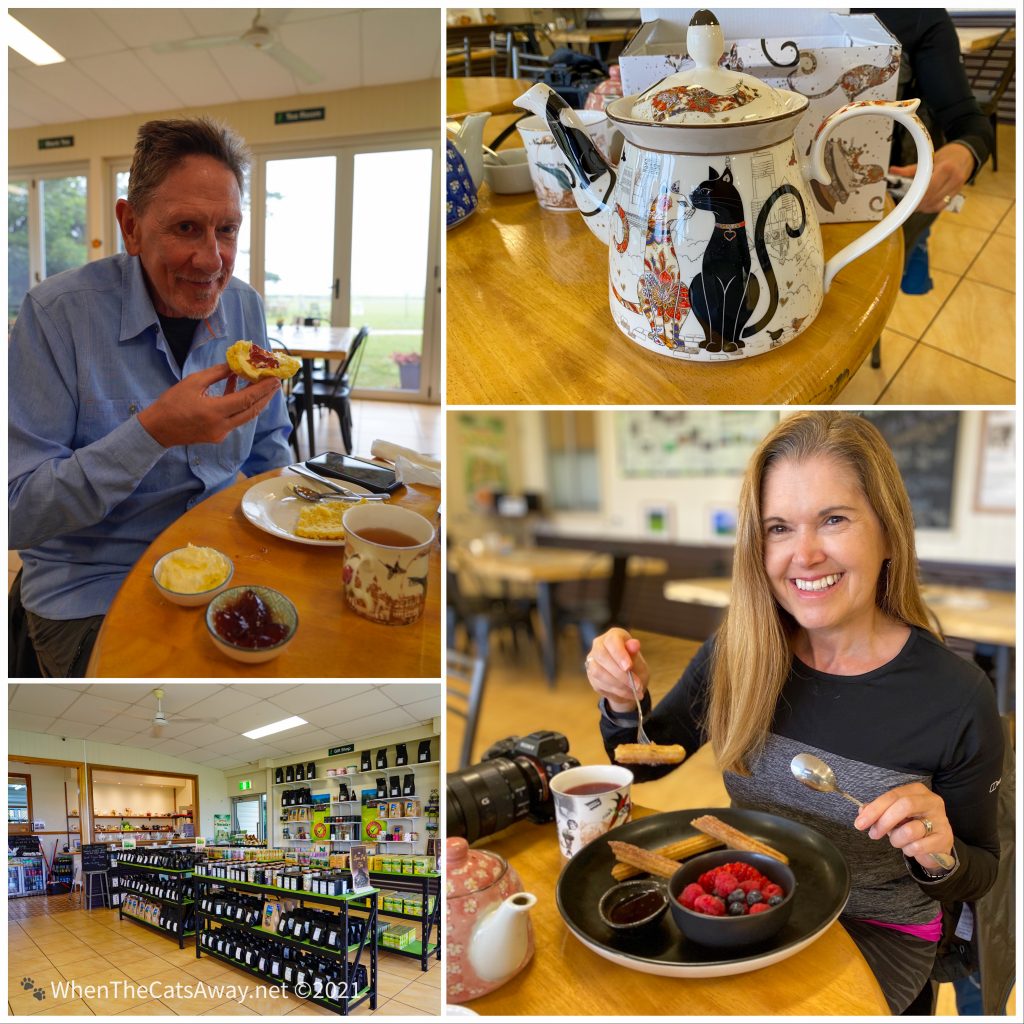
There was an additional reason for our visit however – the little known Lumholtz’s Tree Kangaroos, which we were told lived in the trees around the plantation.
You may be surprised to learn that Australia actually has two types of kangaroo that live in trees, the Lumholtz variety (only found in the Atherton Tablelands), and another the Bennett’s (only found in a small area of rainforest north of Daintree and south of Cooktown, which we were unable to find on our Cape Tribulation visit). There are actually many more varieties which live in Papua New Guinea.
When we had checked into our campground, the owner had told us this was a great place to see them, and that in 24 years only one group of customers had told her they had failed. So, fortified with tea and cake, we set off into the rain to attempt to find one.
It took us about 25 minutes of scouring the trees, walking up and down the road near to the tearooms before suddenly I spotted one. Having no idea what we were looking for, it was a surprise to find they are quite large, and more bear looking than their ground dwelling cousins, but still with the long tail. They evolved from Rock Wallabies around seven million years ago.
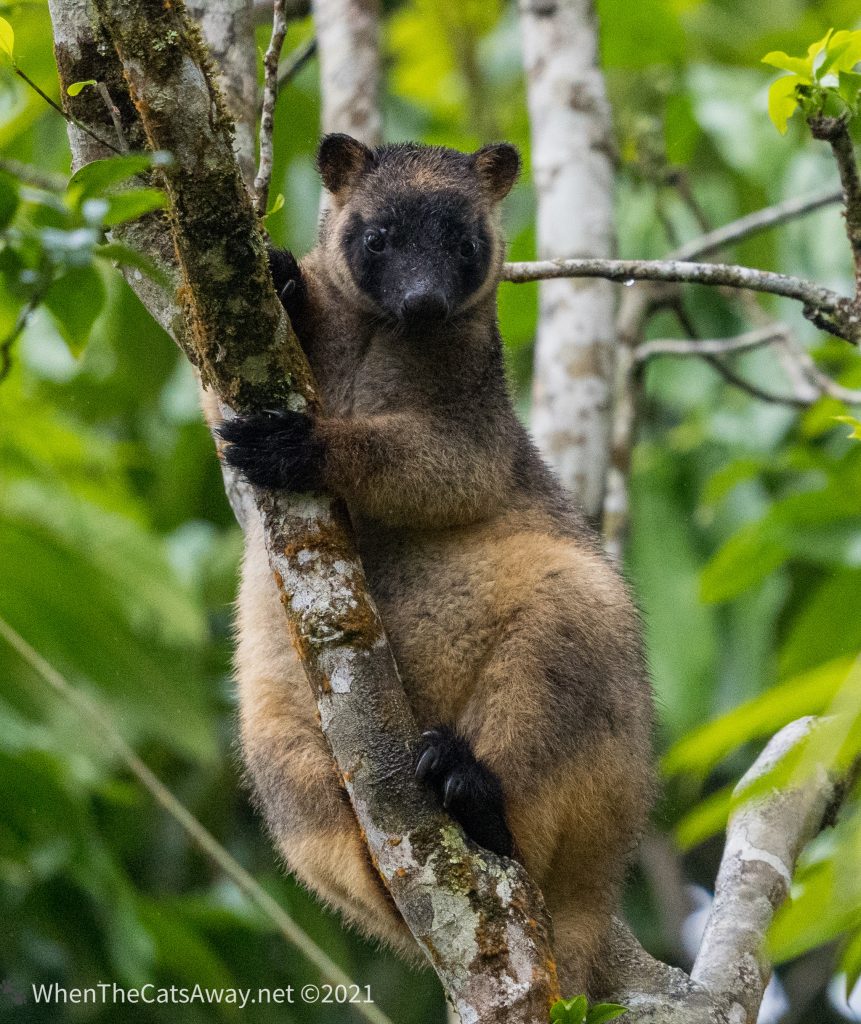
For their size (about the size of a collie dog) they are really quite agile, climbing deftly amongst the branches and munching on several varieties of leaves.
For the Djirrbal and Ngadjon-jii First Nations people these were a significant food source as well as seen as a sacred animal. Being on the near-endangered list, they are no longer hunted and their habitat in this region is being conserved, so their numbers are slowly increasing
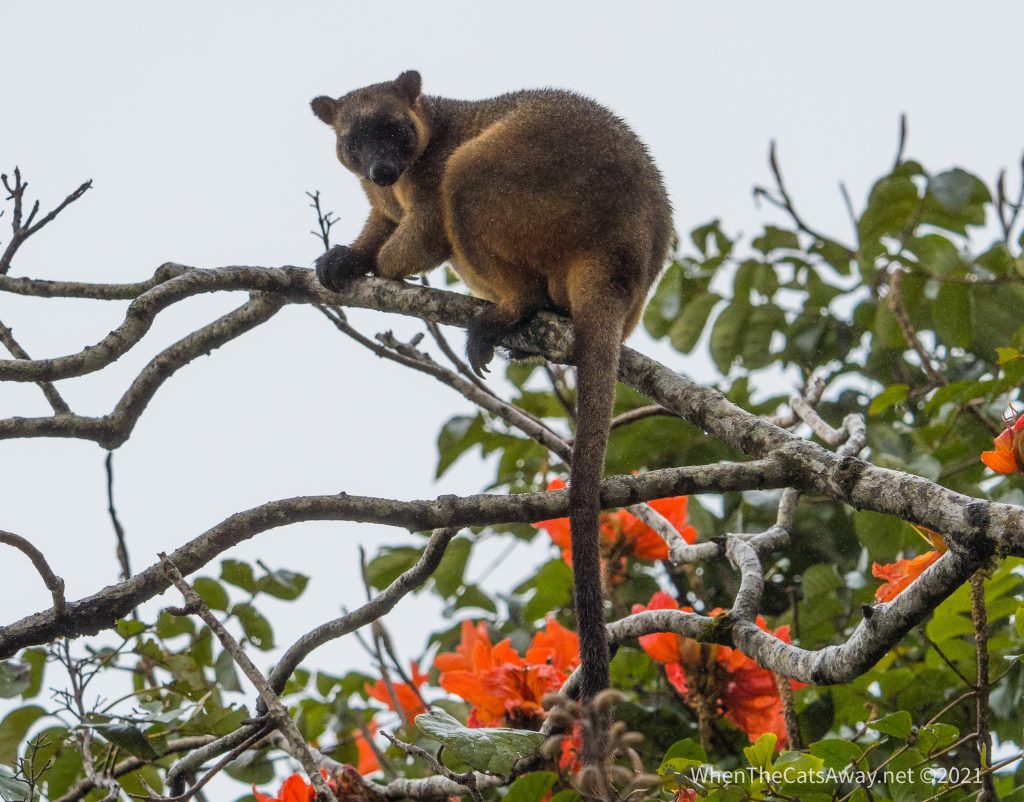
We spent a wonderful hour watching these gorgeous creatures, gathering quite a crowd of other visitors around us as they stopped by to watch them as well. Definitely a memory to treasure and a bucket list item ticked off.
Our campsite beside Malanda Falls was ideally situated about a 15-20 minute drive away from everything we wanted to visit on the Tablelands. The Curtain Fig tree is situated in protected mabi-rainforest with a raised walkway around it, protecting its roots and was where we found ourselves early the following morning.
The tree itself is estimated to be more than 500 years old, and the ‘curtain’ is formed from its many roots which hang down from the main trunk.
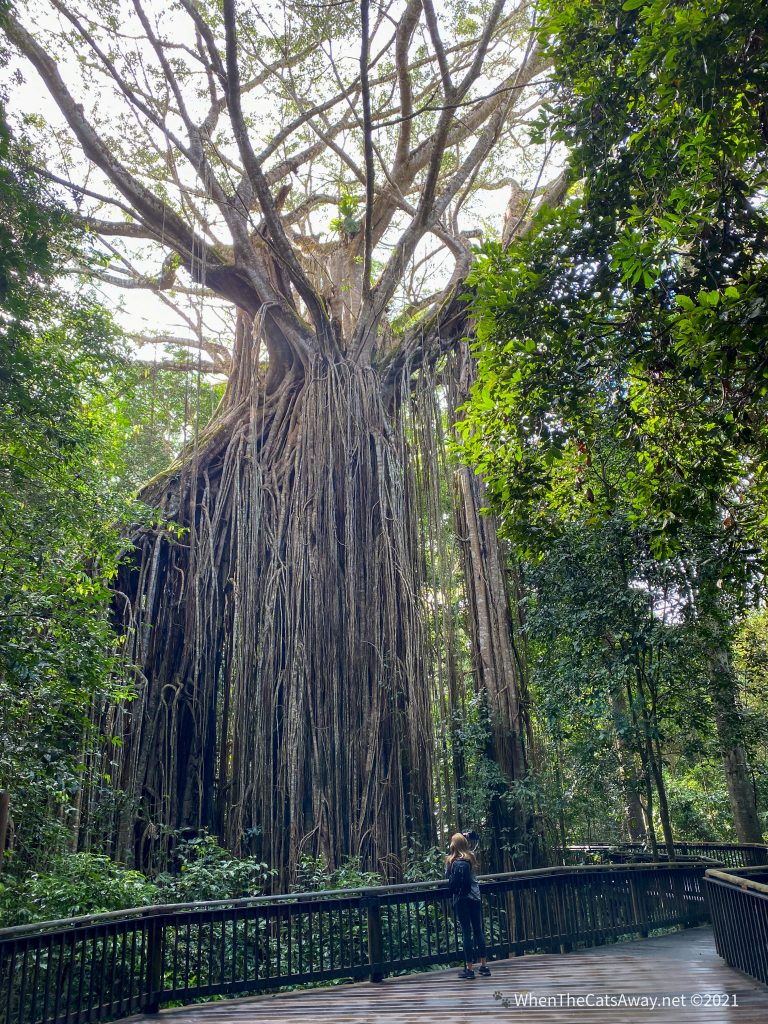
While seeing the tree is in itself a wonder, it is the somewhat rare opportunity to be elevated in rainforest that is also an attraction. The area is important habitat for many birds, tree kangaroos, Red-legged Pademelons (tiny rainforest kangaroos) and rare Musky Rat Kangaroos.
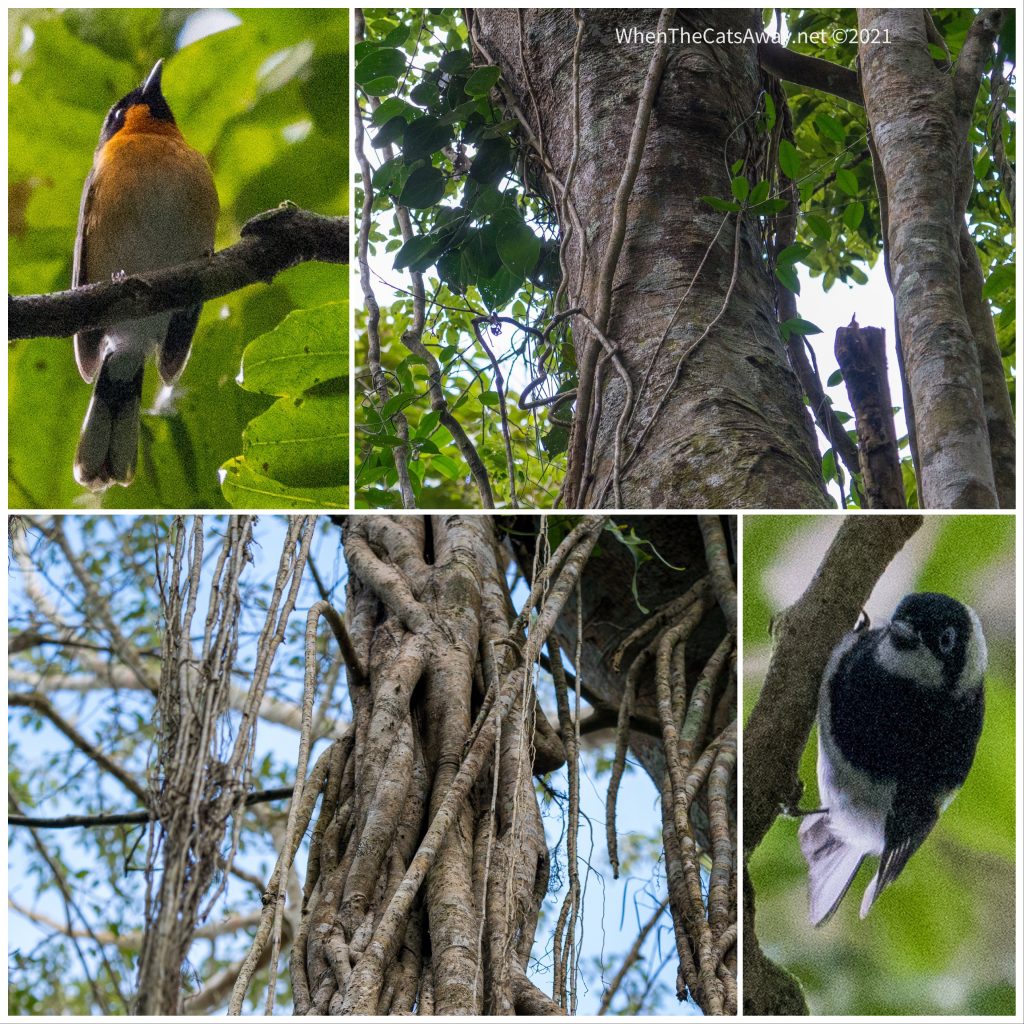
We spent some time listening to the forest, the rustling below the boardwalk, the flash of colour as birds flit between trees. It is not a great place for photography – not only does the camera love to focus on leaves and branches in the foreground, leaving only a blur of a bird in the distance, but the dull light makes it a real challenge to capture a sharp image. I gave it a good go though, and caught a few lovely birds.
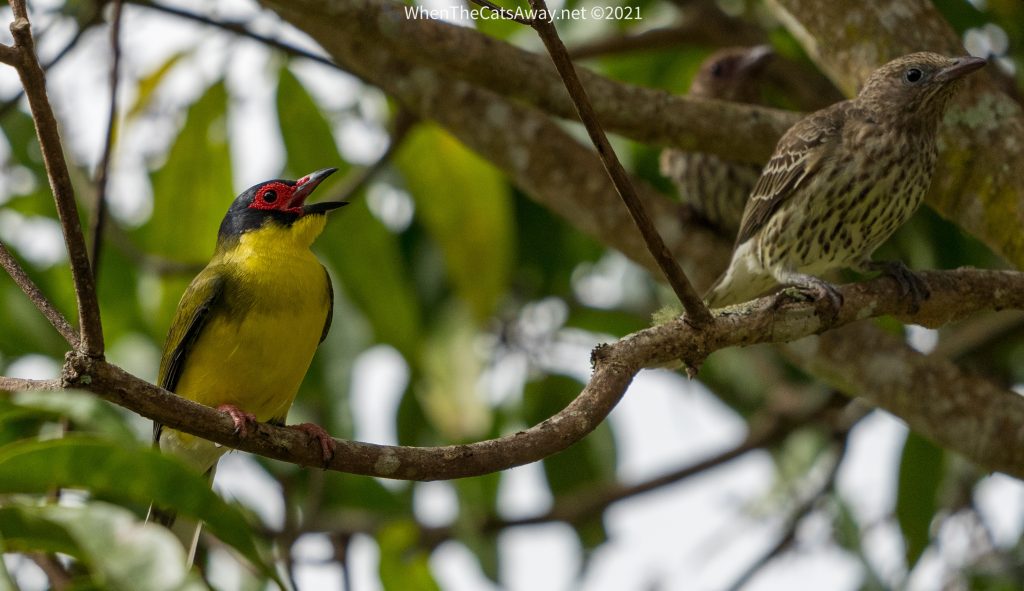
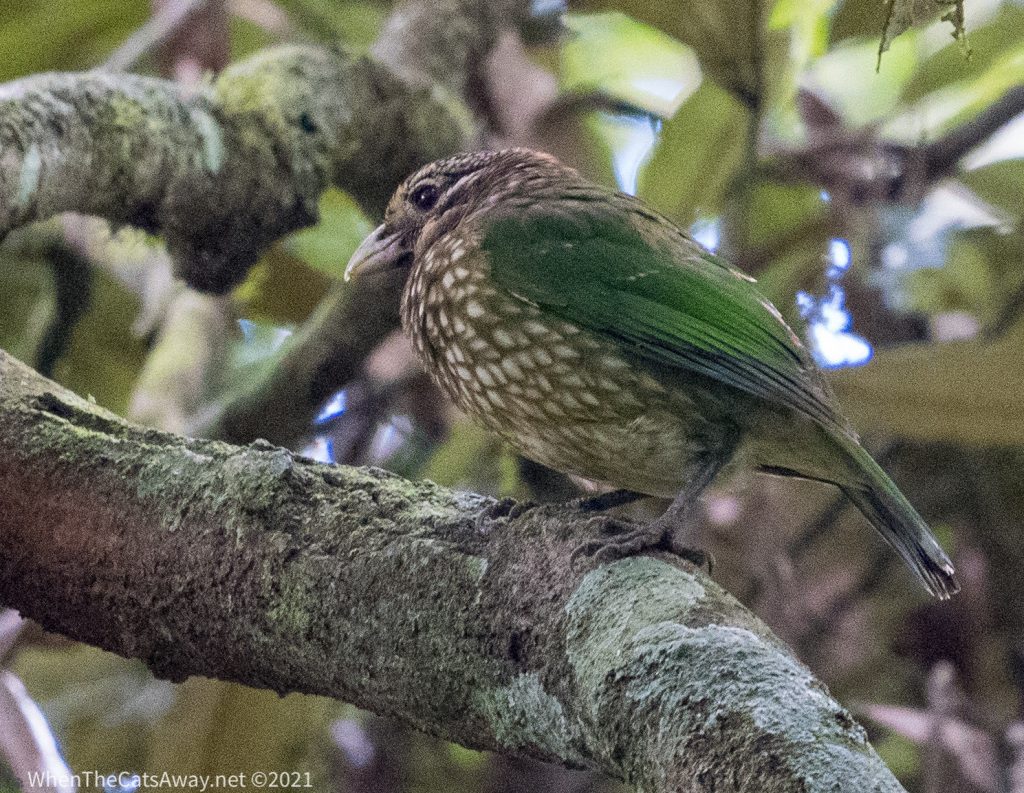
Malanda Falls is located right beside where we were staying, an attractive waterfall a feature of Johnstone River which winds its way through the rainforest. There are a couple of walks through the forest that we explored one afternoon.
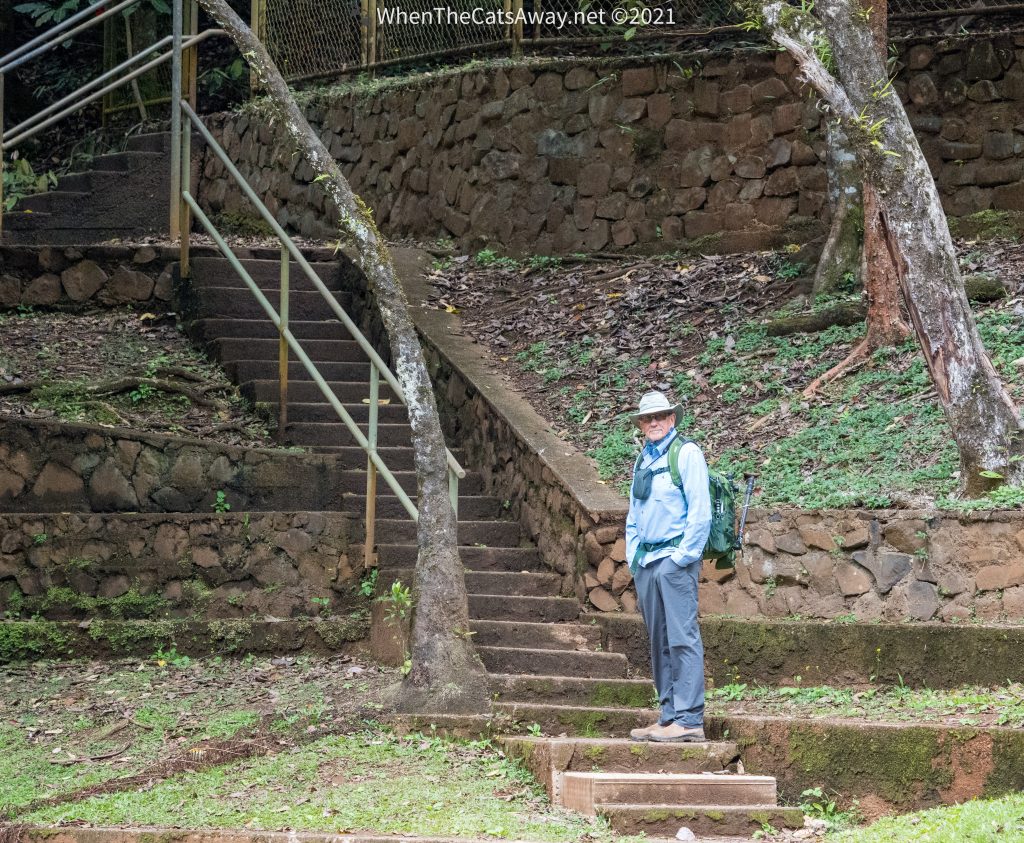
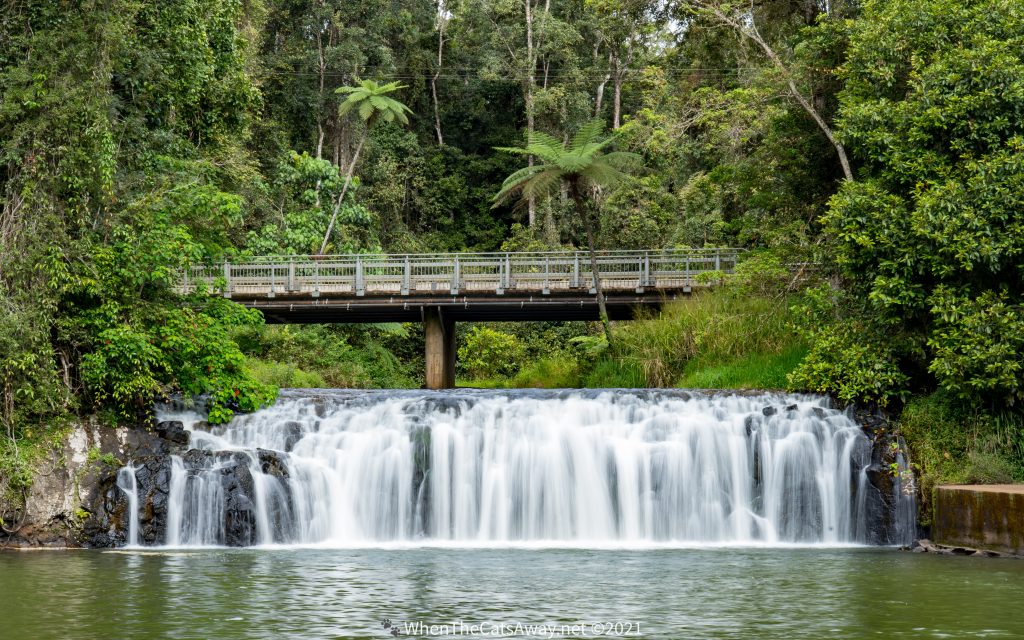
While we saw some birds, they were very hard to see, pausing only briefly before disappearing off into the forest. The river is home to the Johnstone River Snapping Turtle, and there were plenty of these around as we looked from the viewing platforms. There are apparently Platypus living here as well, but they must have been sleeping on our visit.
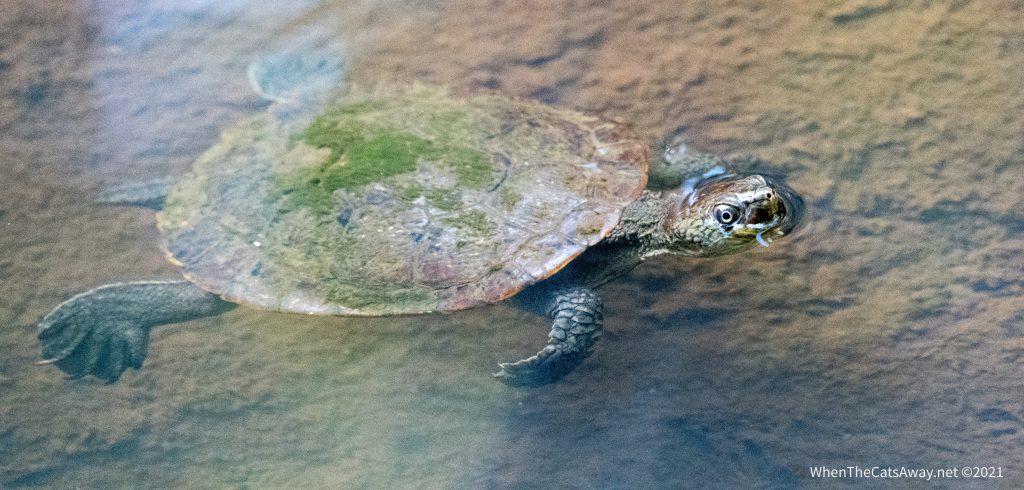
We saw a few shy Red-legged Pademelons.
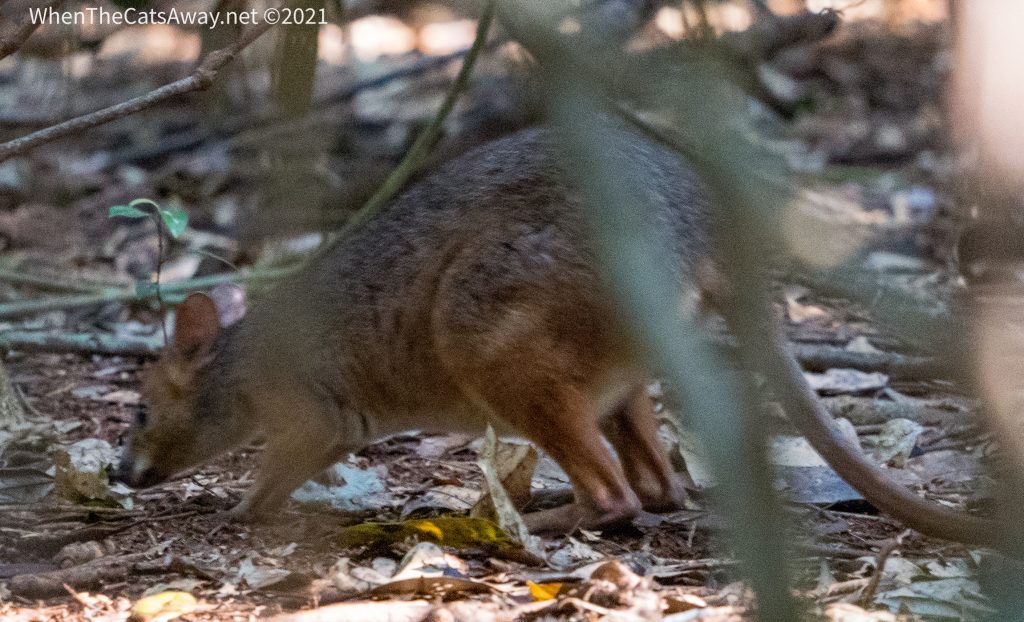
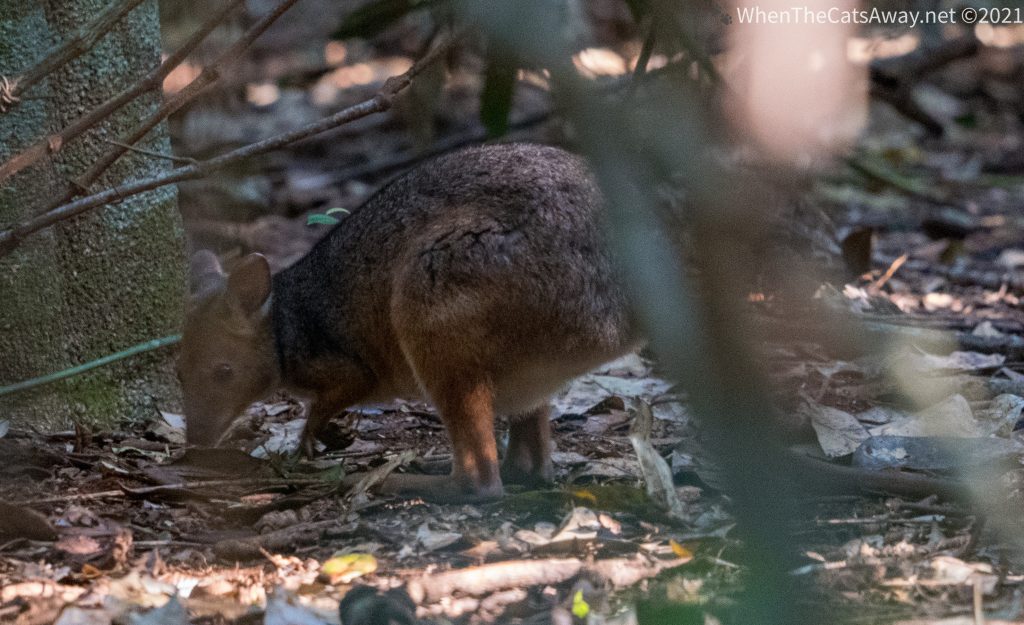
One afternoon we drove out to the unusually named Mount Hypipamee Crater. This is the remains of a volcanic pipe which exploded 8000 years ago – so recent that its eruption also remains told in the stories of the local First Nations people.
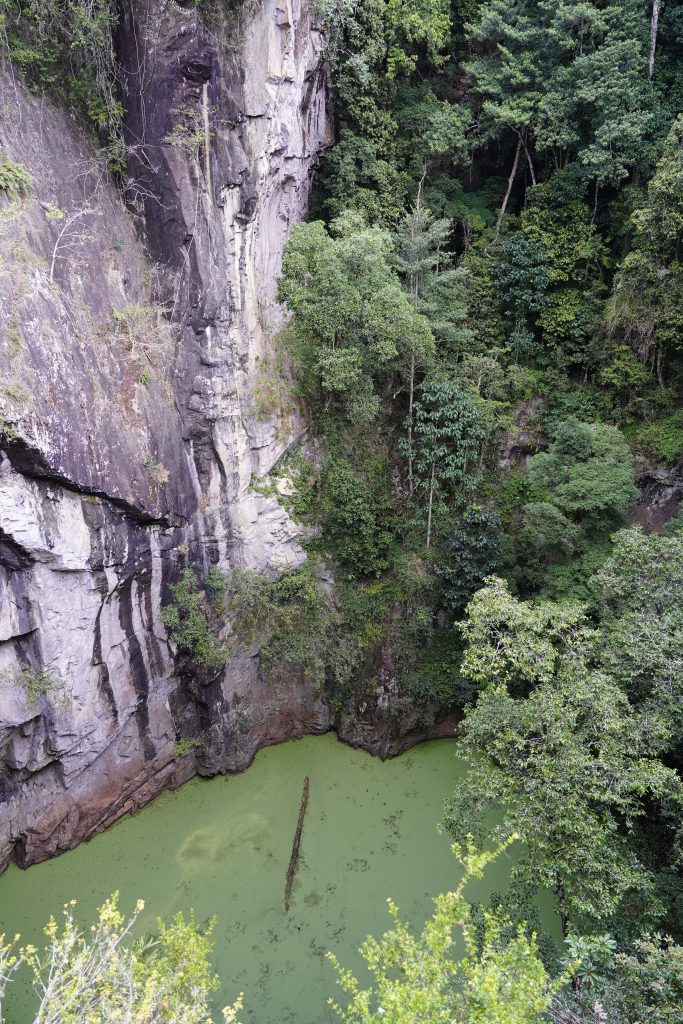
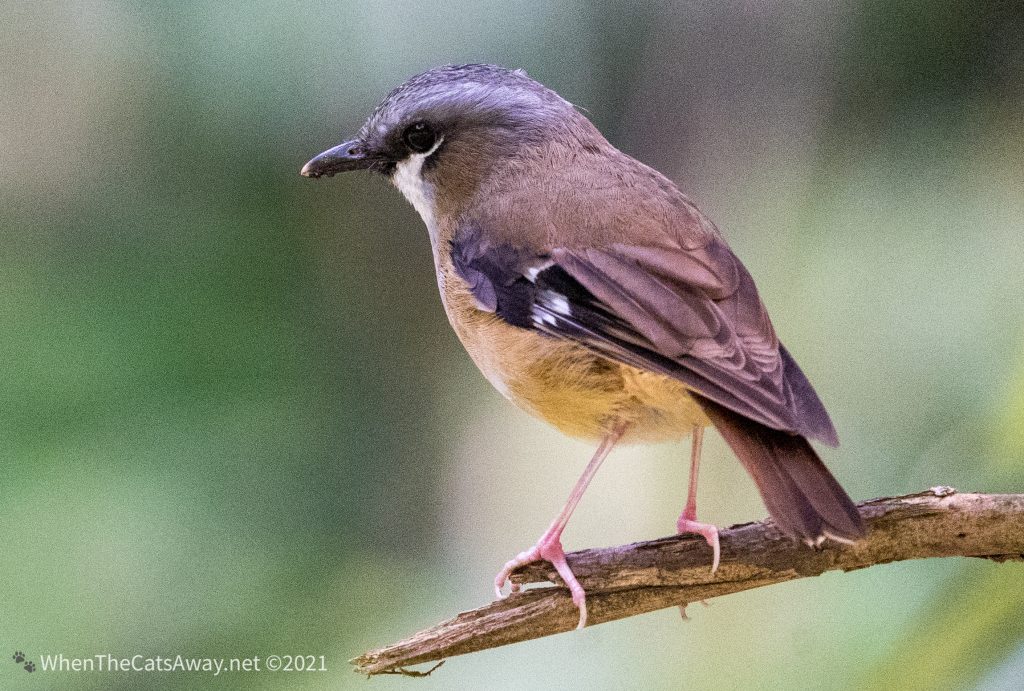
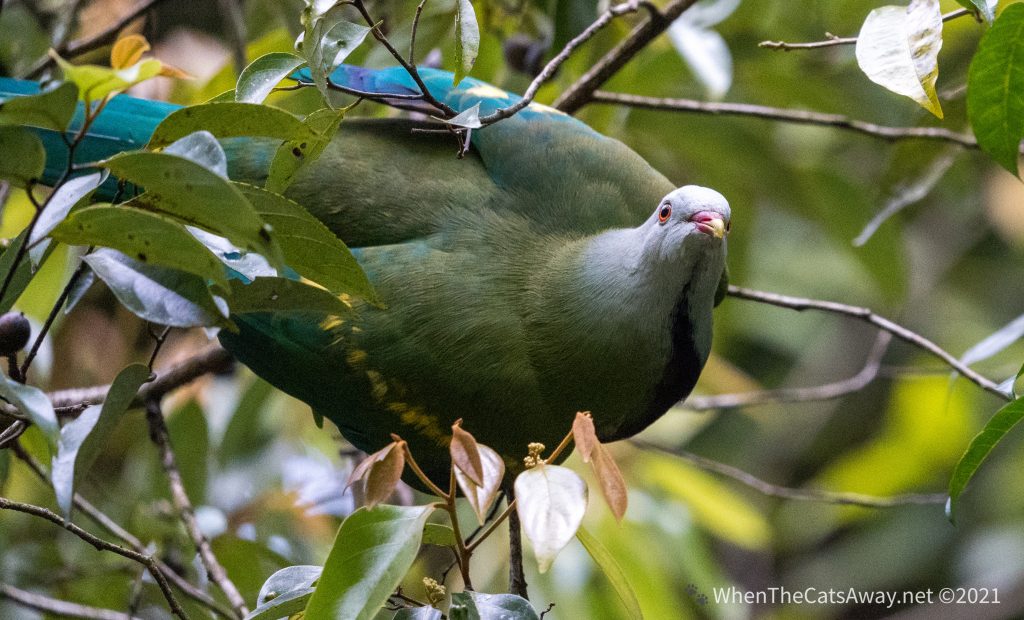
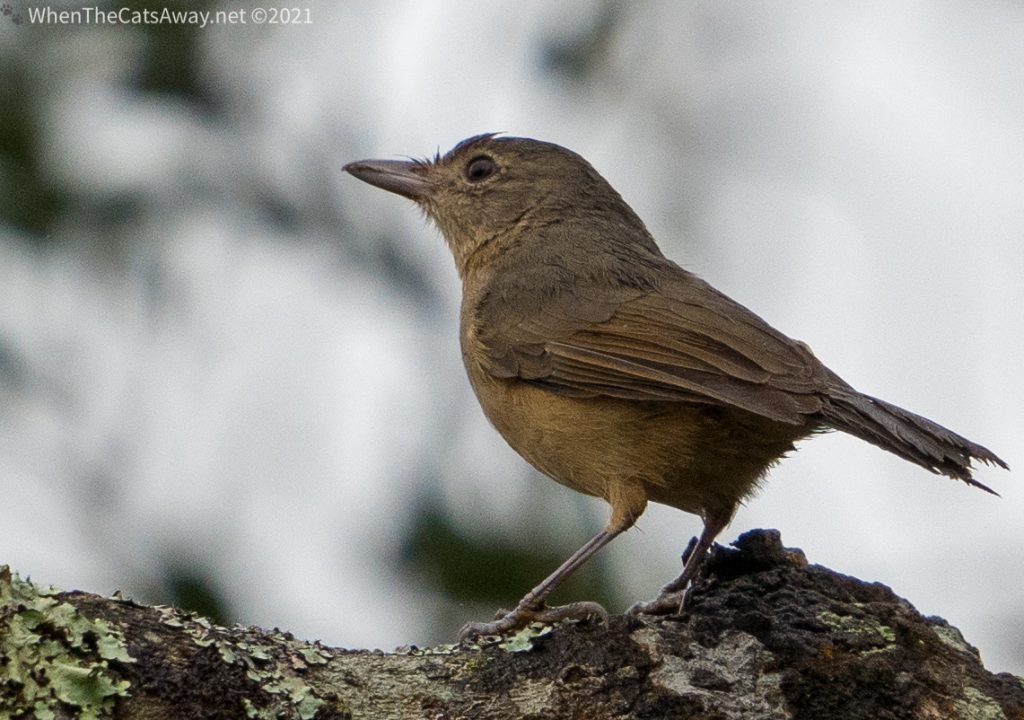
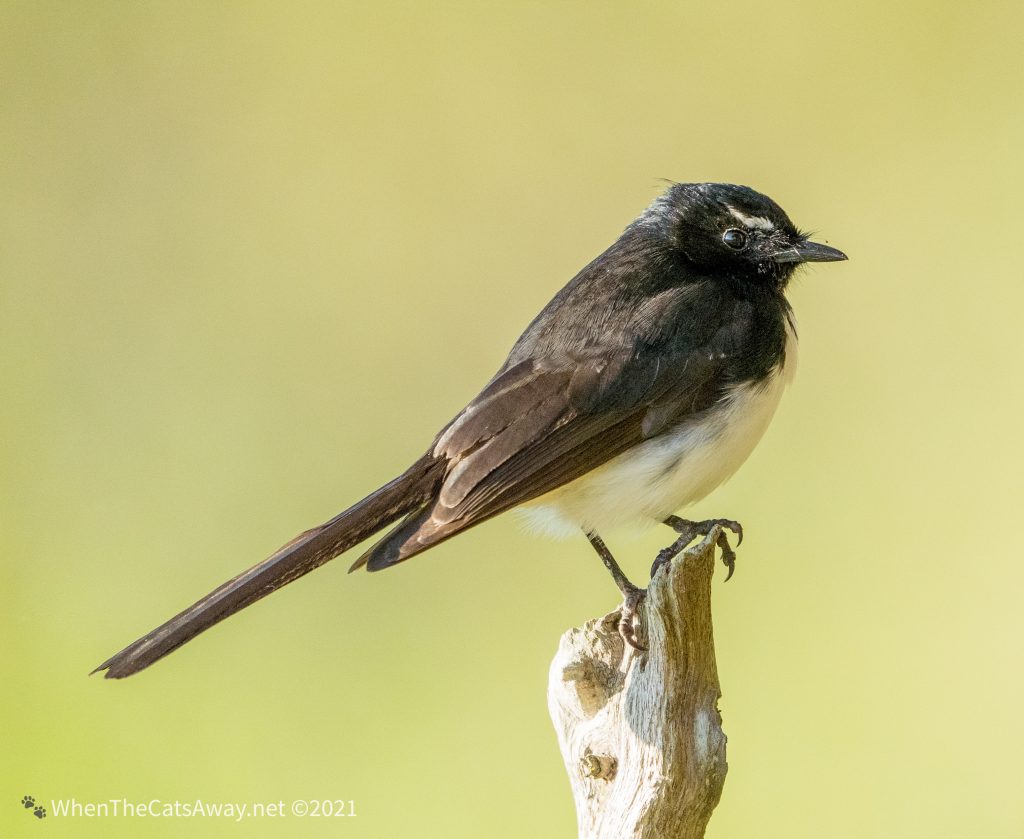
We even spotted another Tree Kangaroo on this visit, right beside the path we were walking along.
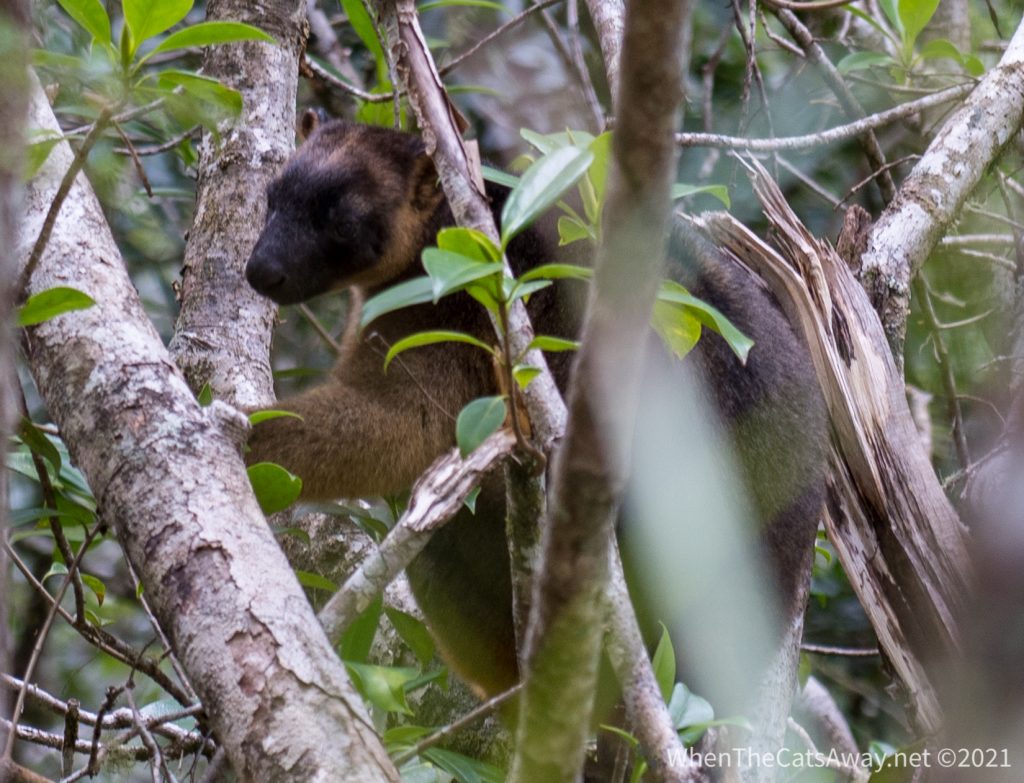
The Upper Barron River runs through Mount Hypipamee National Park, with another walking trail taking you down to Dinner Falls, a series of three cascades cutting their way through the black volcanic granite. This is a popular place for a dip and natural waterfall massage during the summer months.
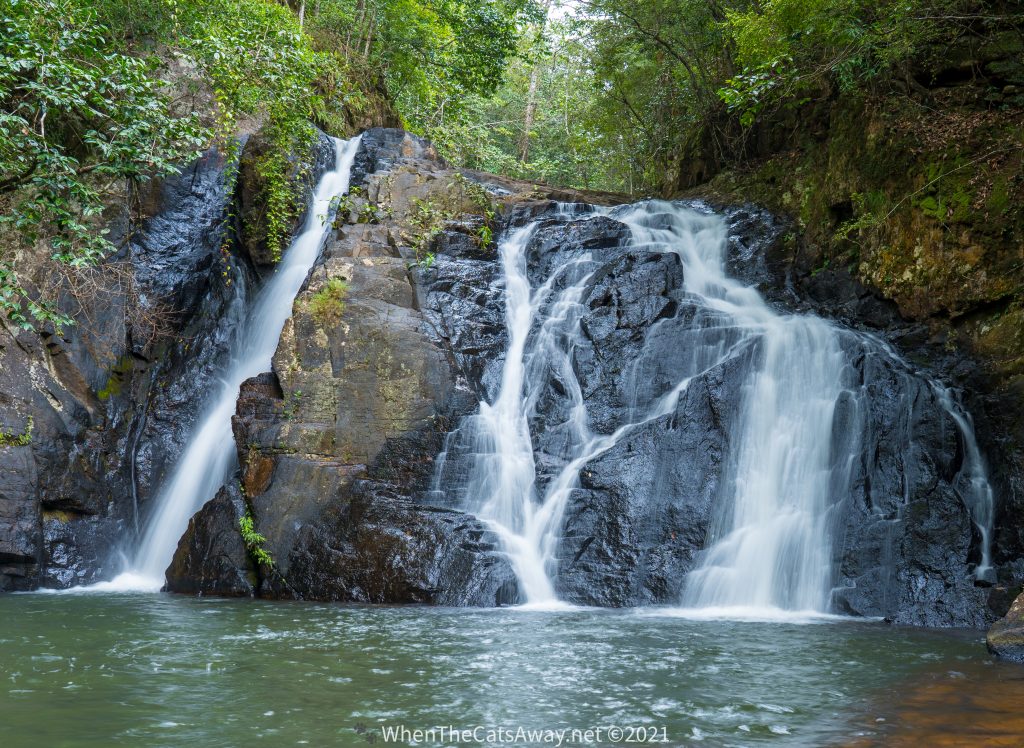
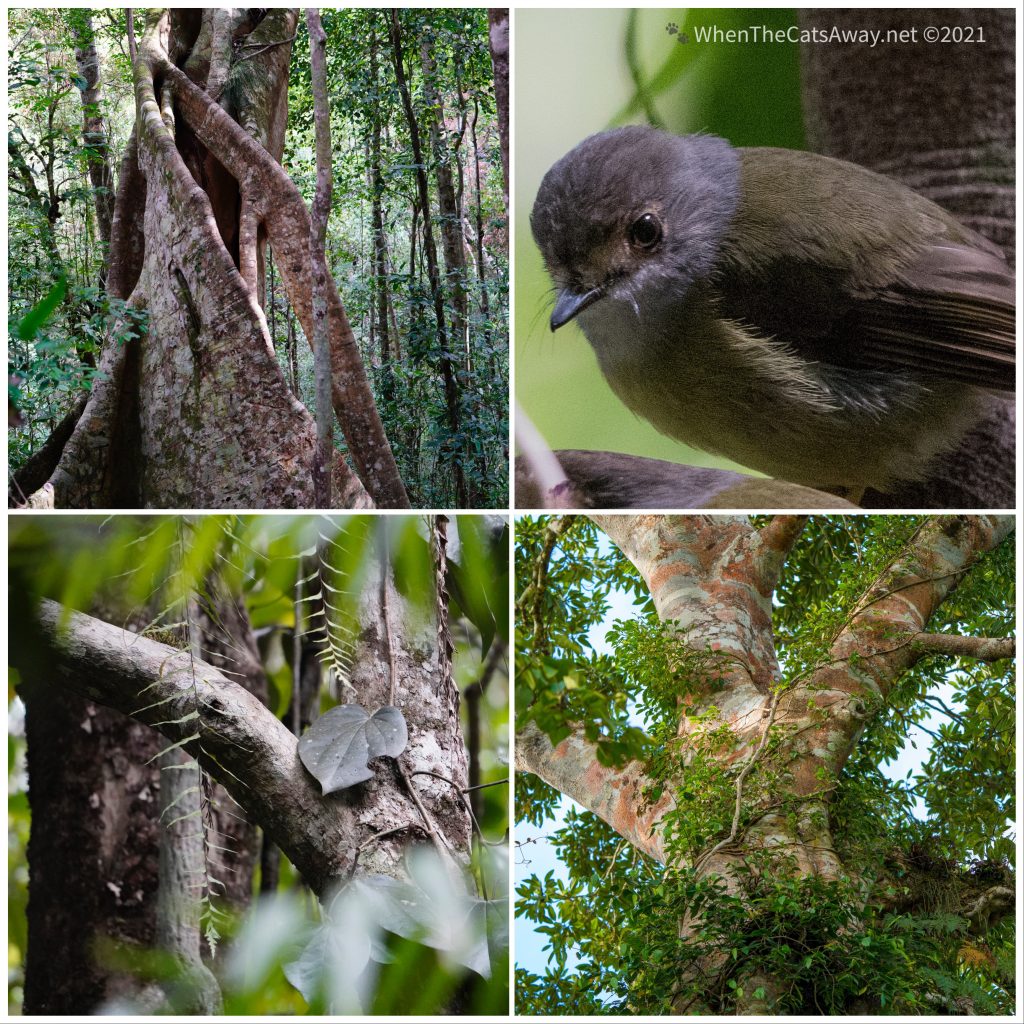
Thursday was an important day – our second Covid-19 vaccination. We had booked in at Atherton Hospital for the injections and didn’t have to wait too long, there wasn’t a queue. As of today, 35% of adult Australians have been fully vaccinated, and an even lower number in Queensland which has been relatively Covid-free these past couple of years, outside of the capital city, Brisbane.
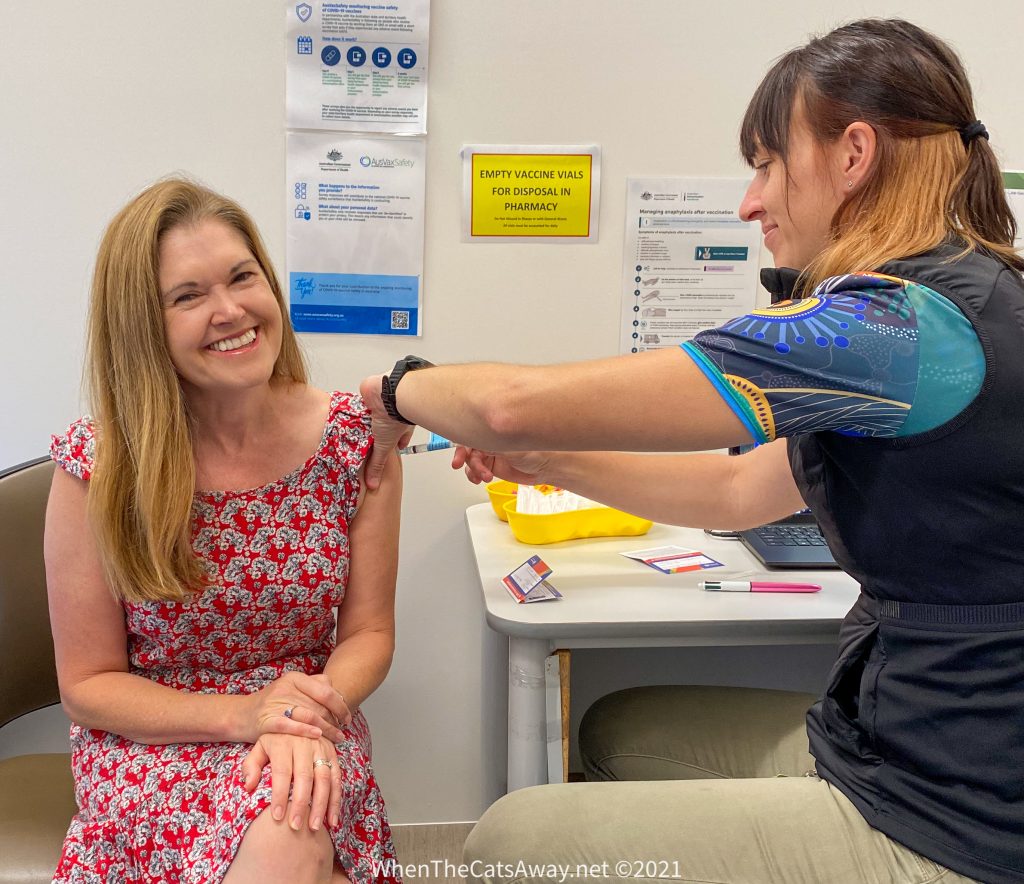

For us, we see the double vaccination as our passport out of lockdowns and the potential to get back out there in the world and travel. It’s a means of keeping us safe and hopefully out of hospital should we catch the virus. While most people we meet travelling are of the same mind as us – not keen to have their freedoms curbed any longer and excited to get back to touring Australia and the world – we have also met a number of hesitant people. They tend to be people who are unlikely to travel, who have never met anyone who has been unwell with Covid-19, let alone experienced the horror of someone passing away from the virus. We hope they can be persuaded to be inoculated for the greater community good – our government has pledged to open up more privileges once we are at 80% vaccinated, which feels a long way off.
On a couple of occasions during our six day stay we took ourselves over to Hasties Swamp National Park, a nearby wetland with a two storey bird hide, finding late afternoon to be the best time for action. It was a good opportunity for Mark to finally get out his spotting scope – the rainforest birds simply do not sit still long enough to get the scope lined up for a good look, but water birds tend to be a little less flighty.
We saw a large range of birds, the usual kingfishers, several varieties of honeyeater and Plumed and Wandering Whistling Ducks. The sound at the wetland was absolutely deafening, predominantly the loud honking of a huge flock of Magpie Geese which had noisily taken over one end of the water, constantly squabbling and flying around trying to find the optimum location to spend the night.
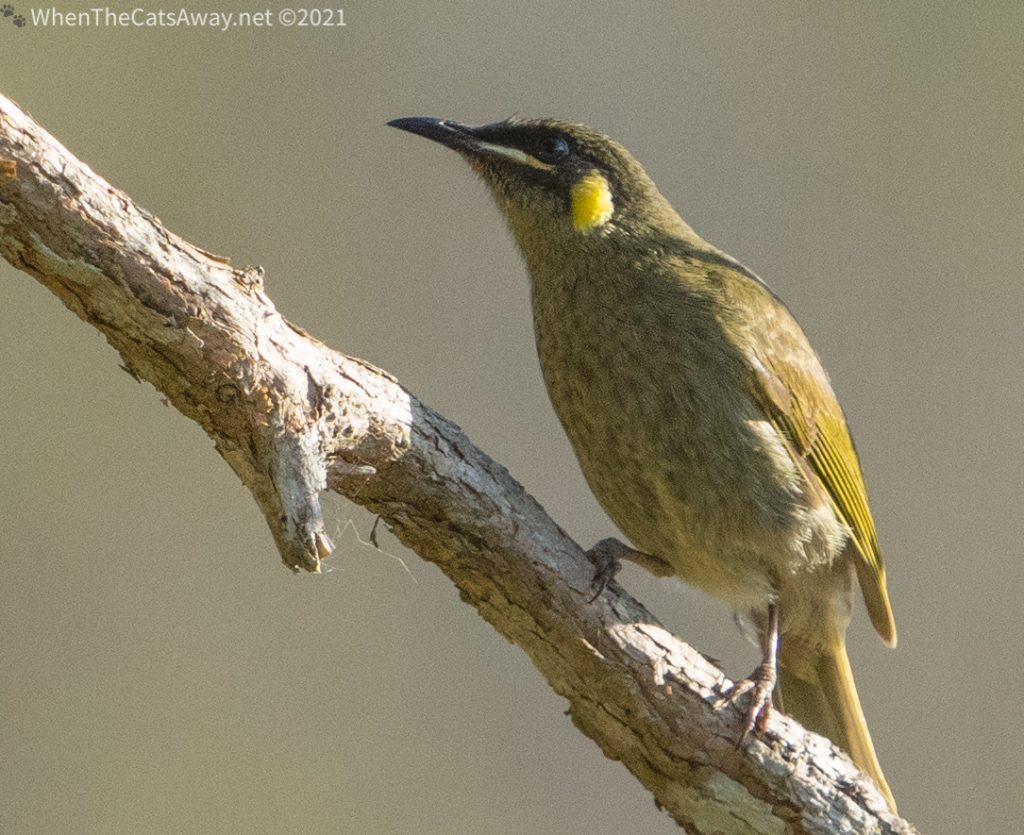
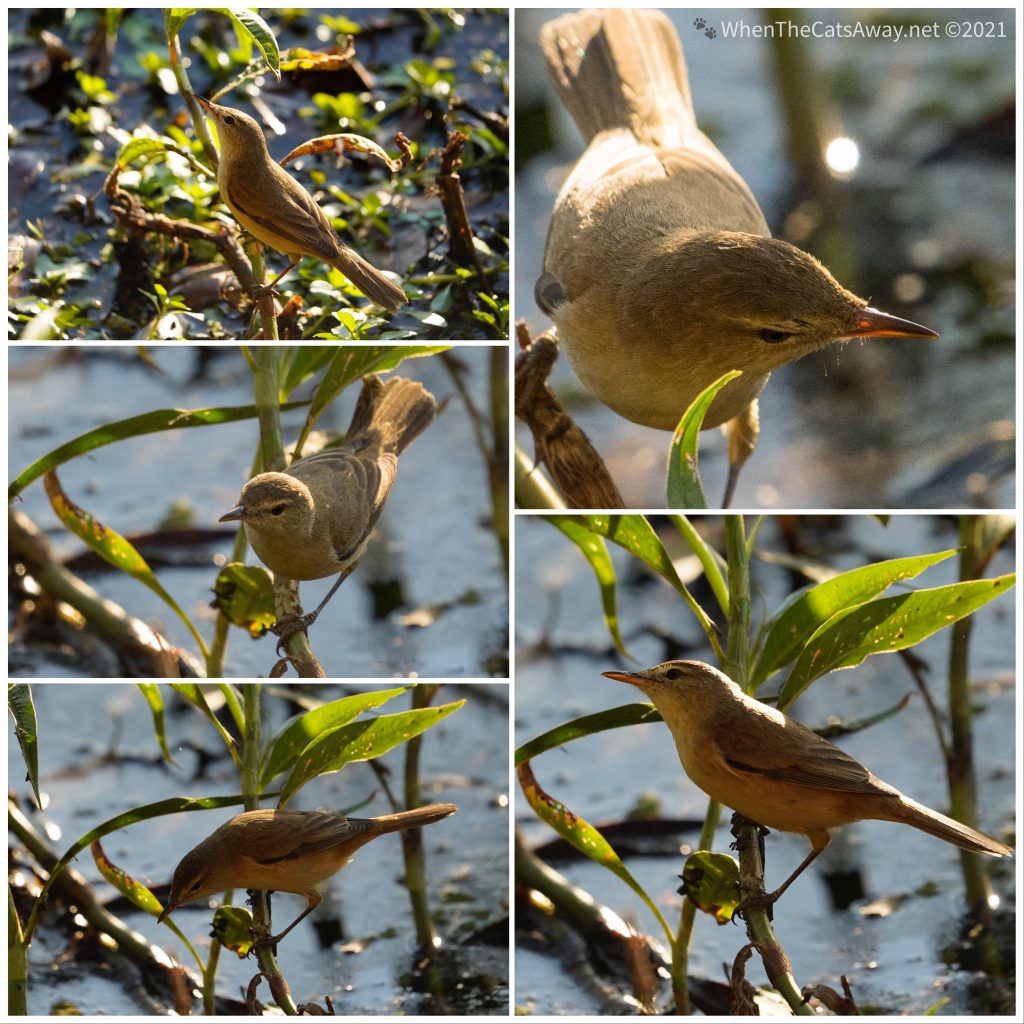
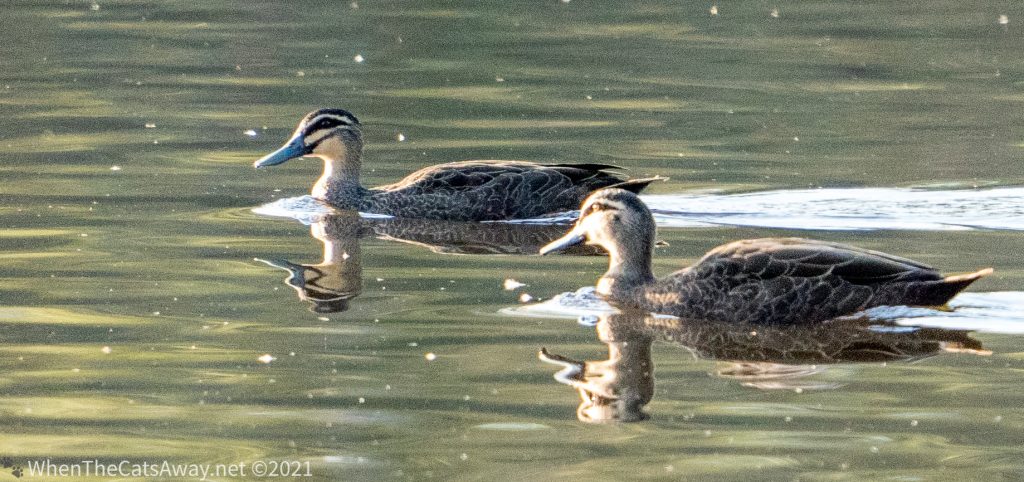
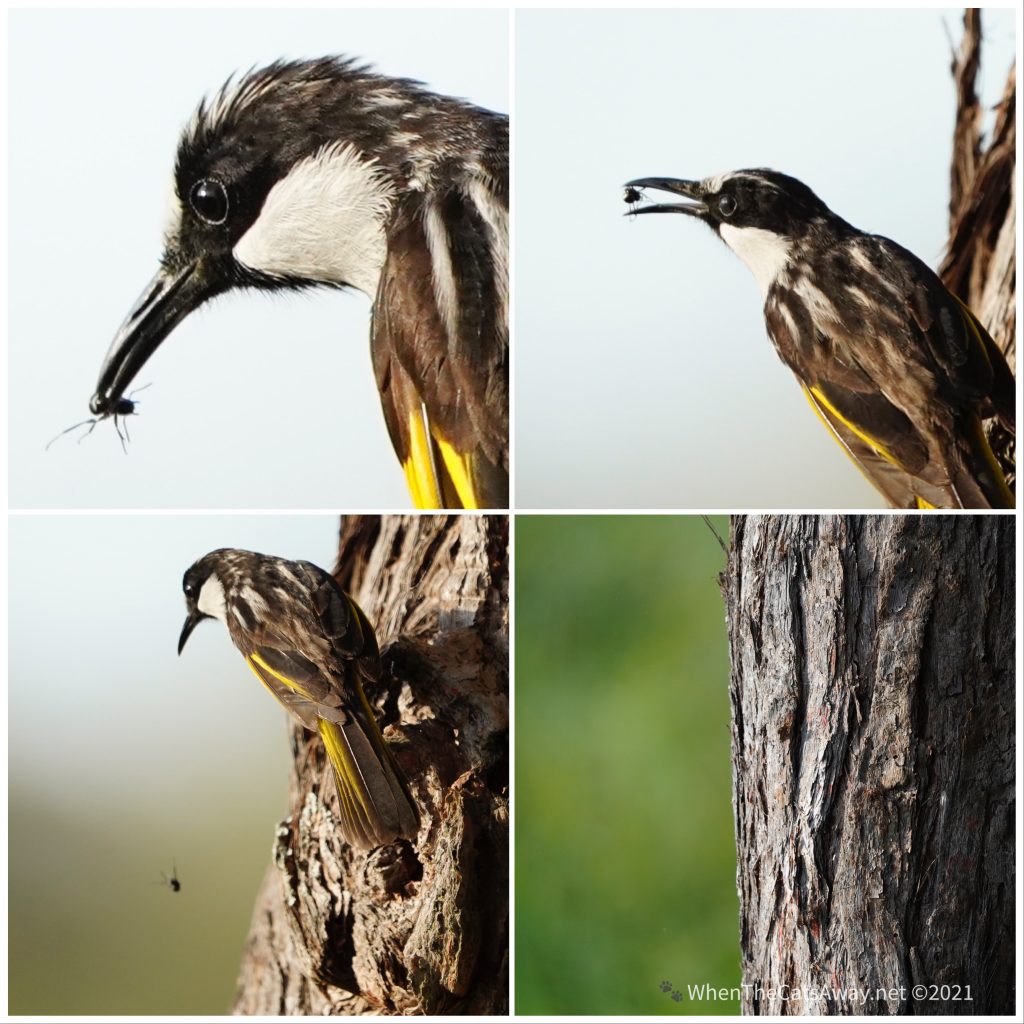
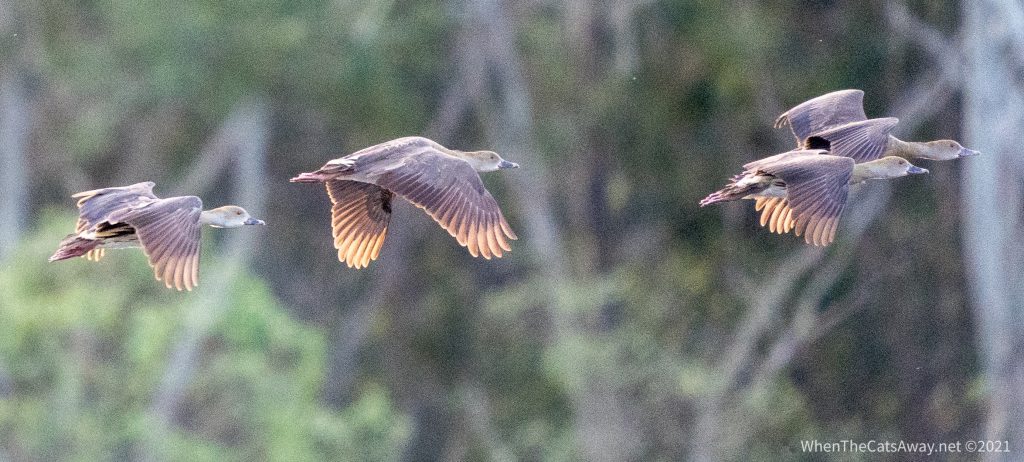
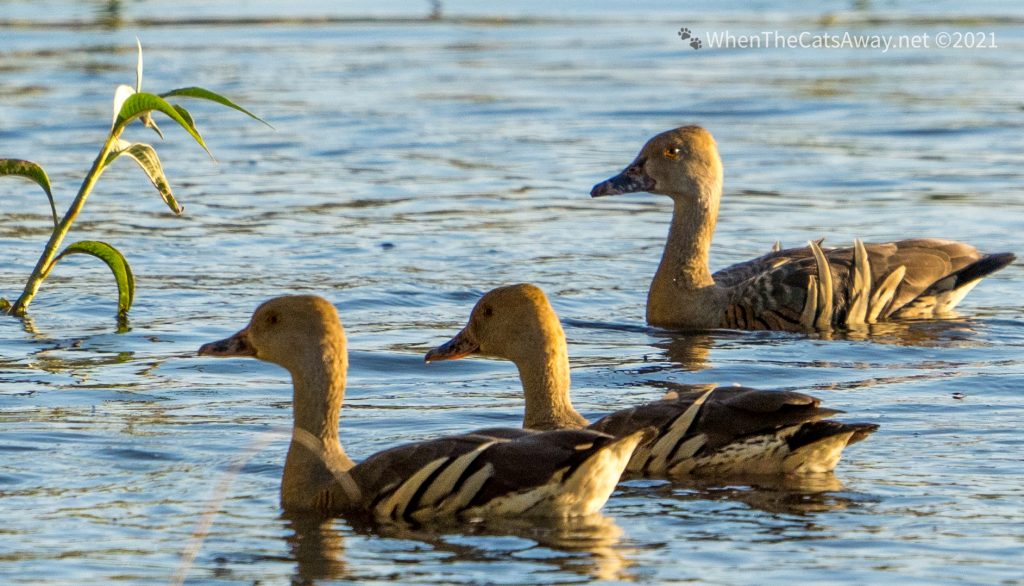
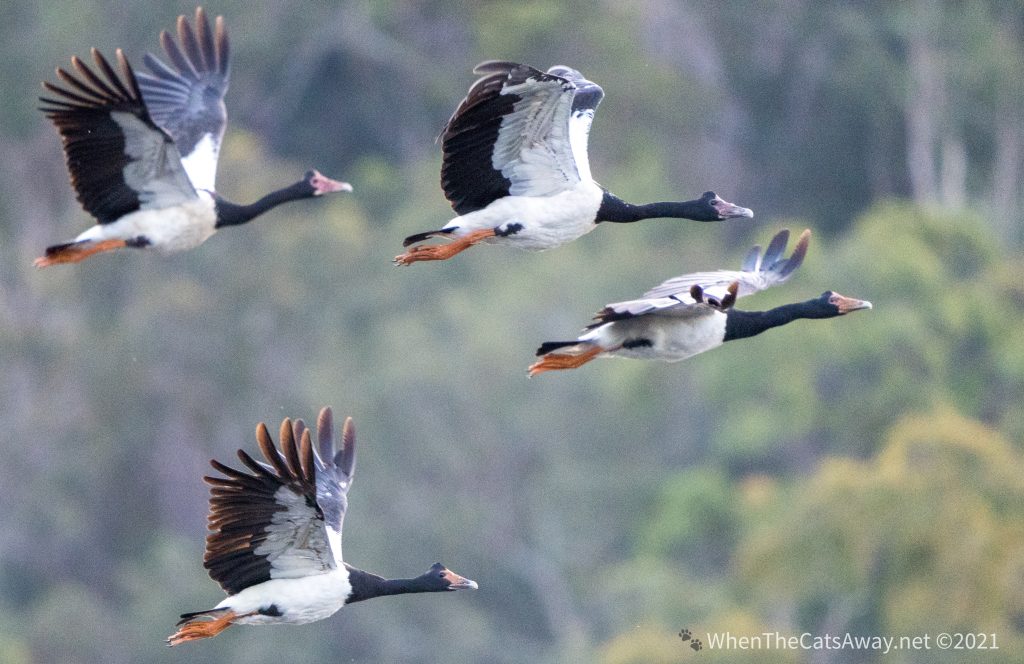
On our final day, we took ourselves off to do a walk around Lake Eacham. While there are apparently Freshwater Crocodiles living here (smaller and less aggressive than their saltwater cousins), people can go swimming and kayaking in this small lake, and we saw a group of teenagers shrieking as they leaped into the cold water. We stuck to land for our visit and followed a trail around the water, through the dense rainforest of Crater Lakes National Park.
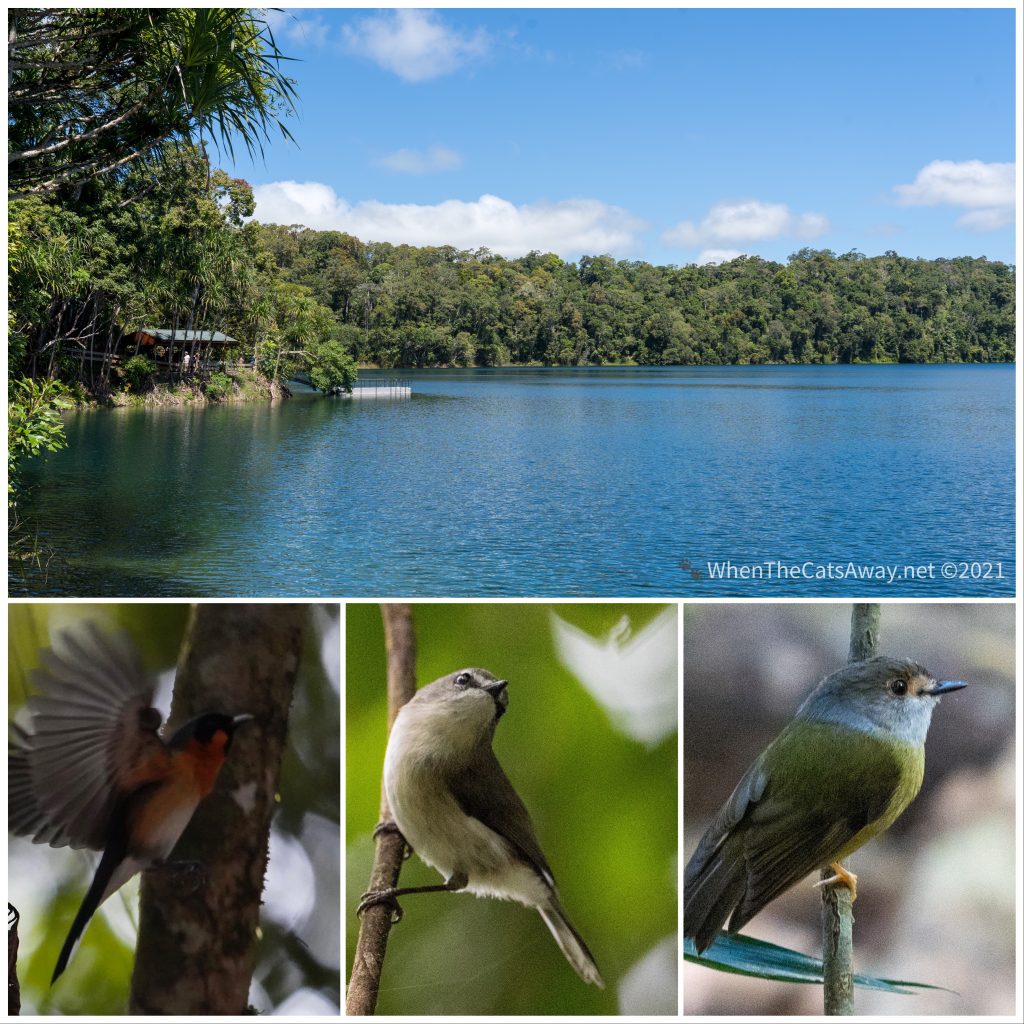
It was another bucket-list native I was rather keen to see; a Victoria’s Riflebird. We had visited the lake earlier in the week and constantly heard them calling, but none were to be seen. These birds are only found in this area of Australia, and are famous for their vibrant colouring and fabulous dance to attract females. I highly recommend you watch their dance moves on YouTube, they are incredible.
So half way around the lake, I heard a loud Riflebird-like squark from high up in the trees, and spotted a black-coloured bird hopping around in the branches. Yes! A Riflebird! I got set up with the camera, willing it to come closer.
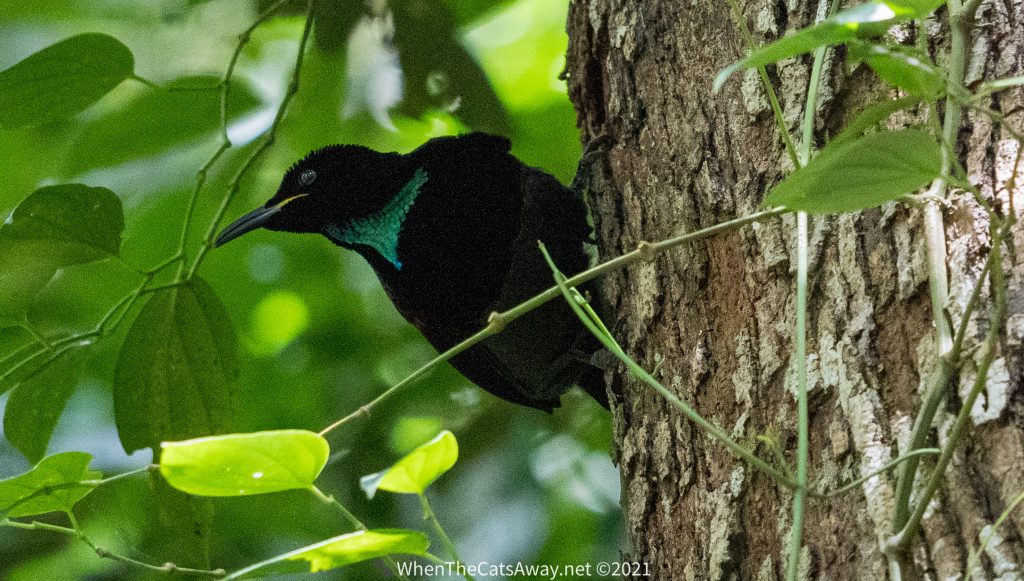
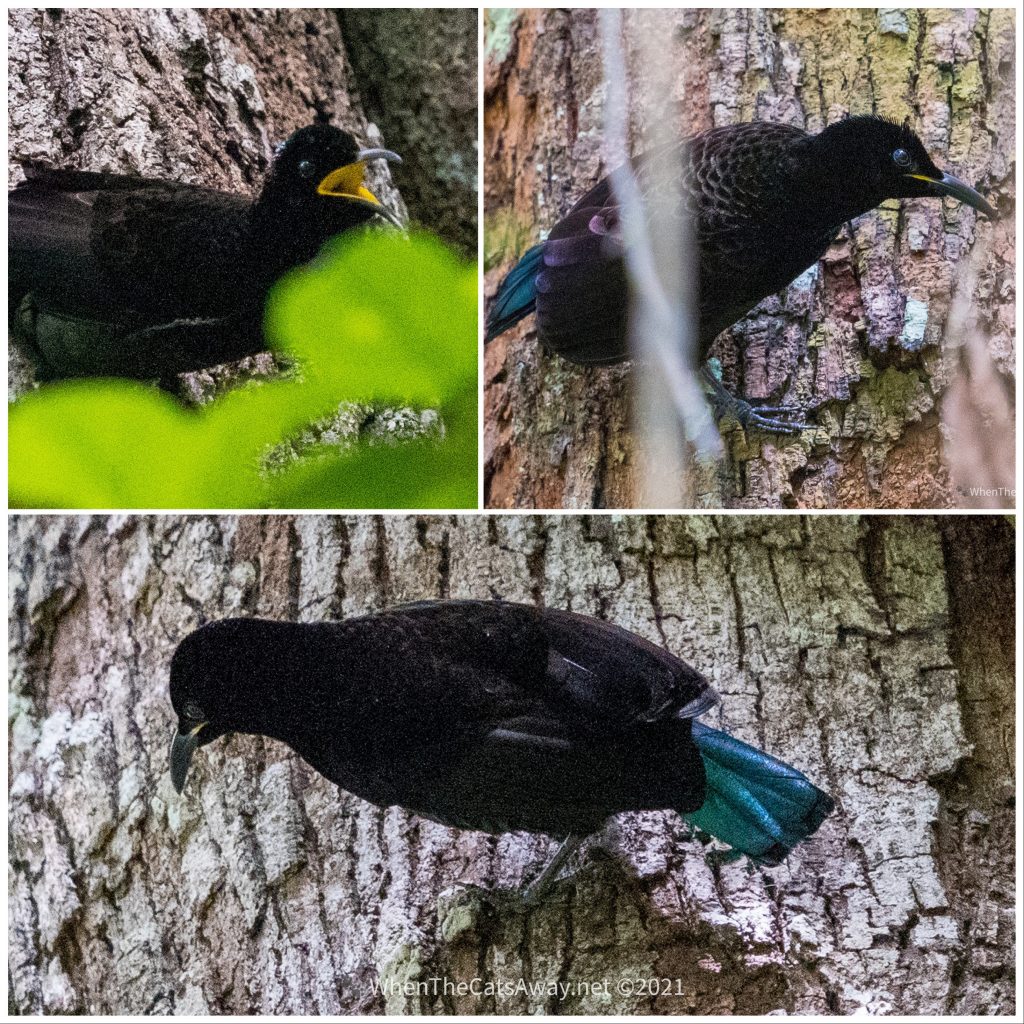
The gorgeous bird was lifting up pieces of bark and finding insects and grubs to eat. I watched it methodically work its way along the trunk until suddenly a particularly tasty looking snack dropped from its grasp and fell to the ground just a metre or two from me, swiftly followed by the Riflebird. I held my breath, willing my camera to focus on the right thing as he found his food and flew up to an old tree trunk just metres in front of me, providing a perfect view of his glistening head, throat and chest feathers. Just incredible.
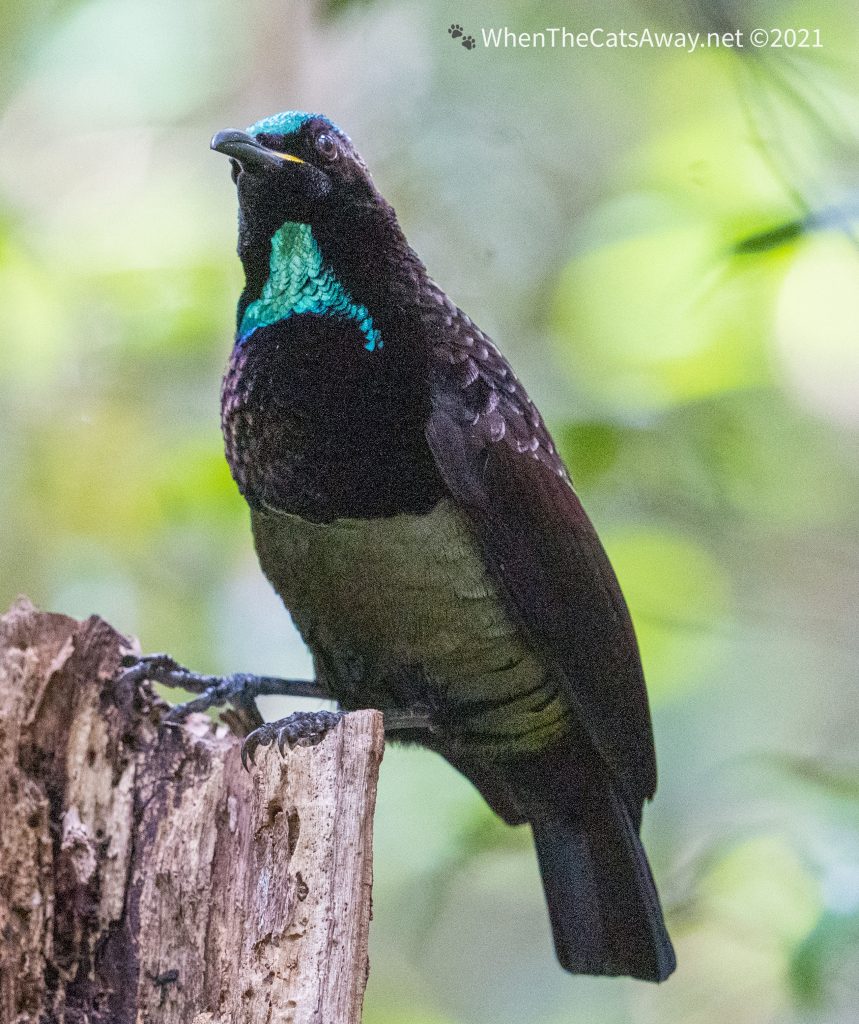
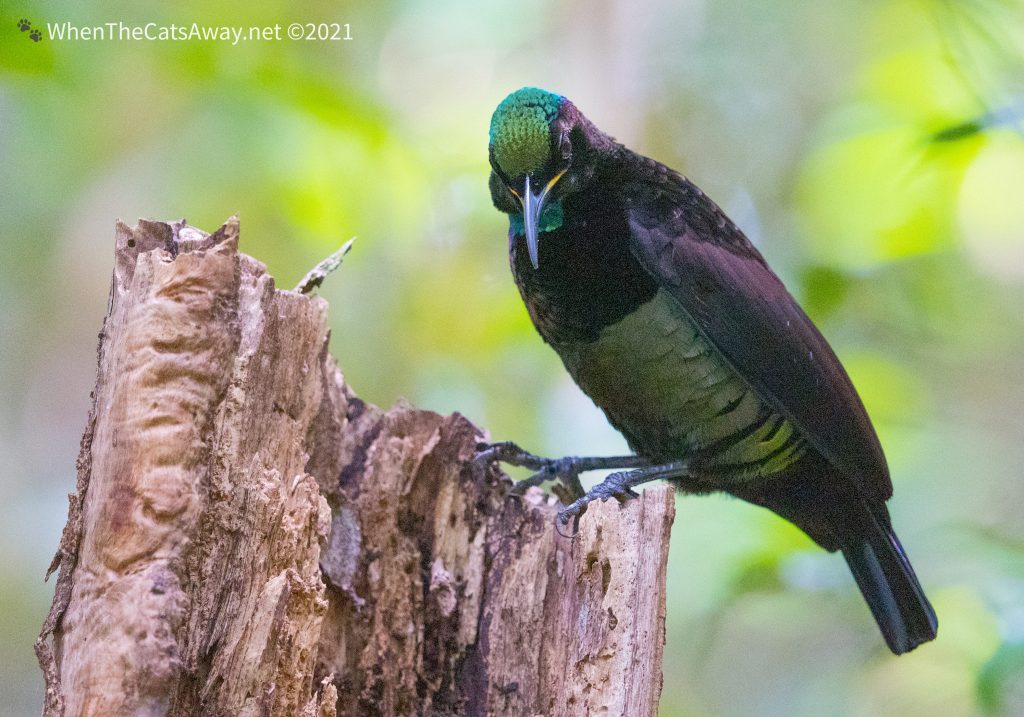
I was so chuffed to have been rewarded with this special moment, an absolutely wonderful end to our visit to the Tablelands. I was only disappointed that Mark missed the show as he had walked on ahead of me. Thank goodness I was able to capture some photographs to share with him.
We’ve spent a magical three weeks exploring this rainforest-filled tropical north Queensland, longer than we have ever done before. Rewarded with incredible bird and animal sightings, we feel so privileged to have been able to take our time and immerse ourselves in this special environment. But now it is time to turn our noses south, and start making our way down the east coast. We have a bit of celebrating to be done in Noosa with friends!

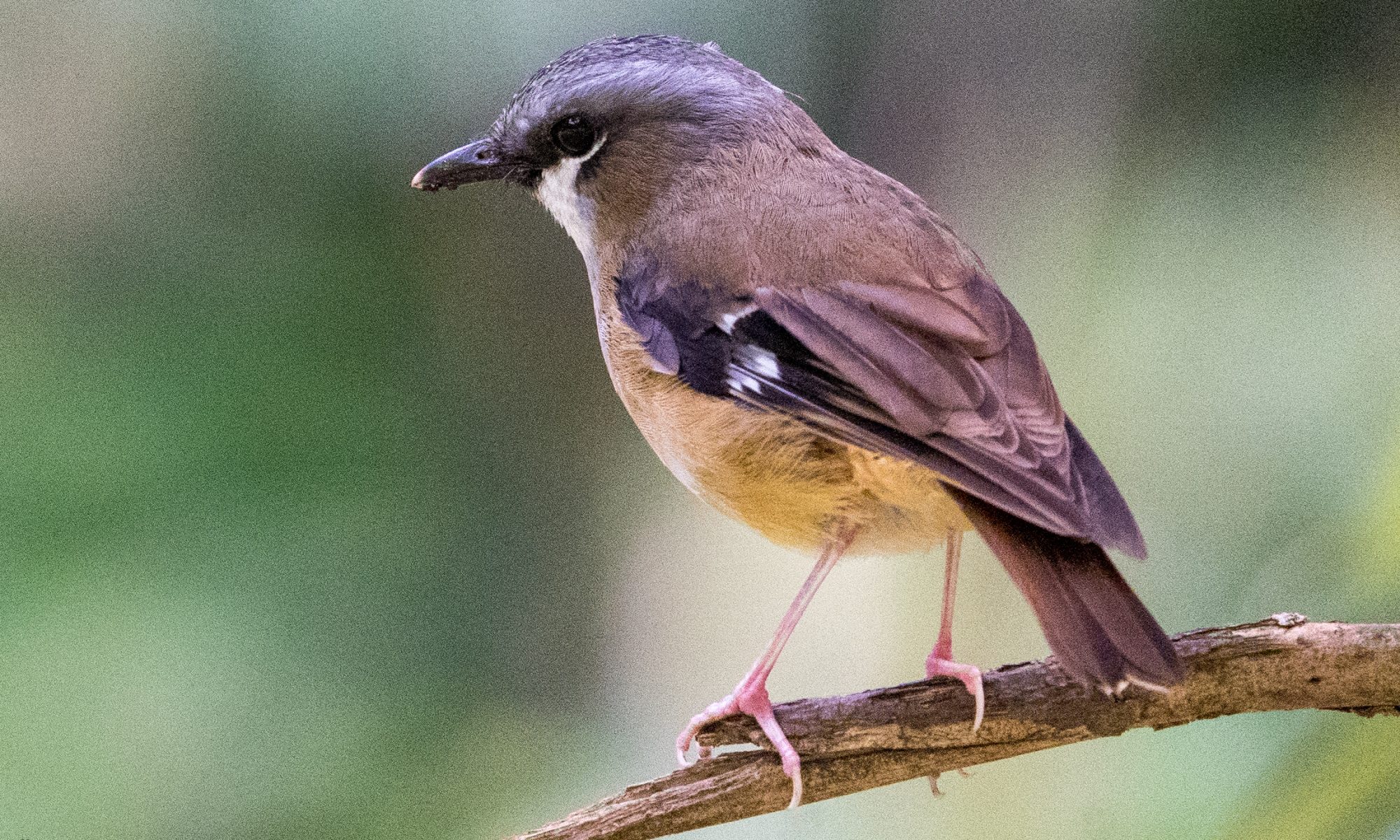
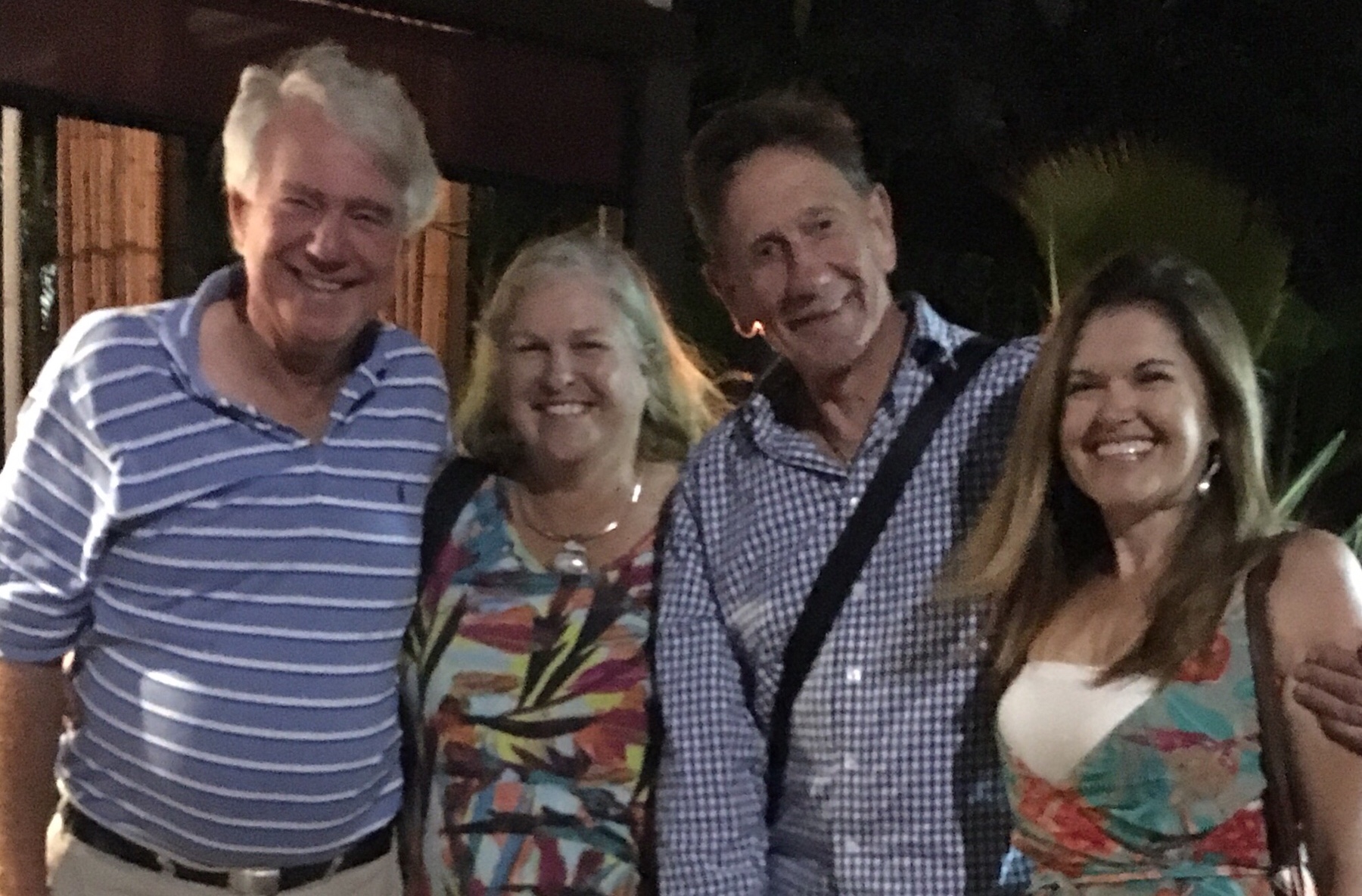
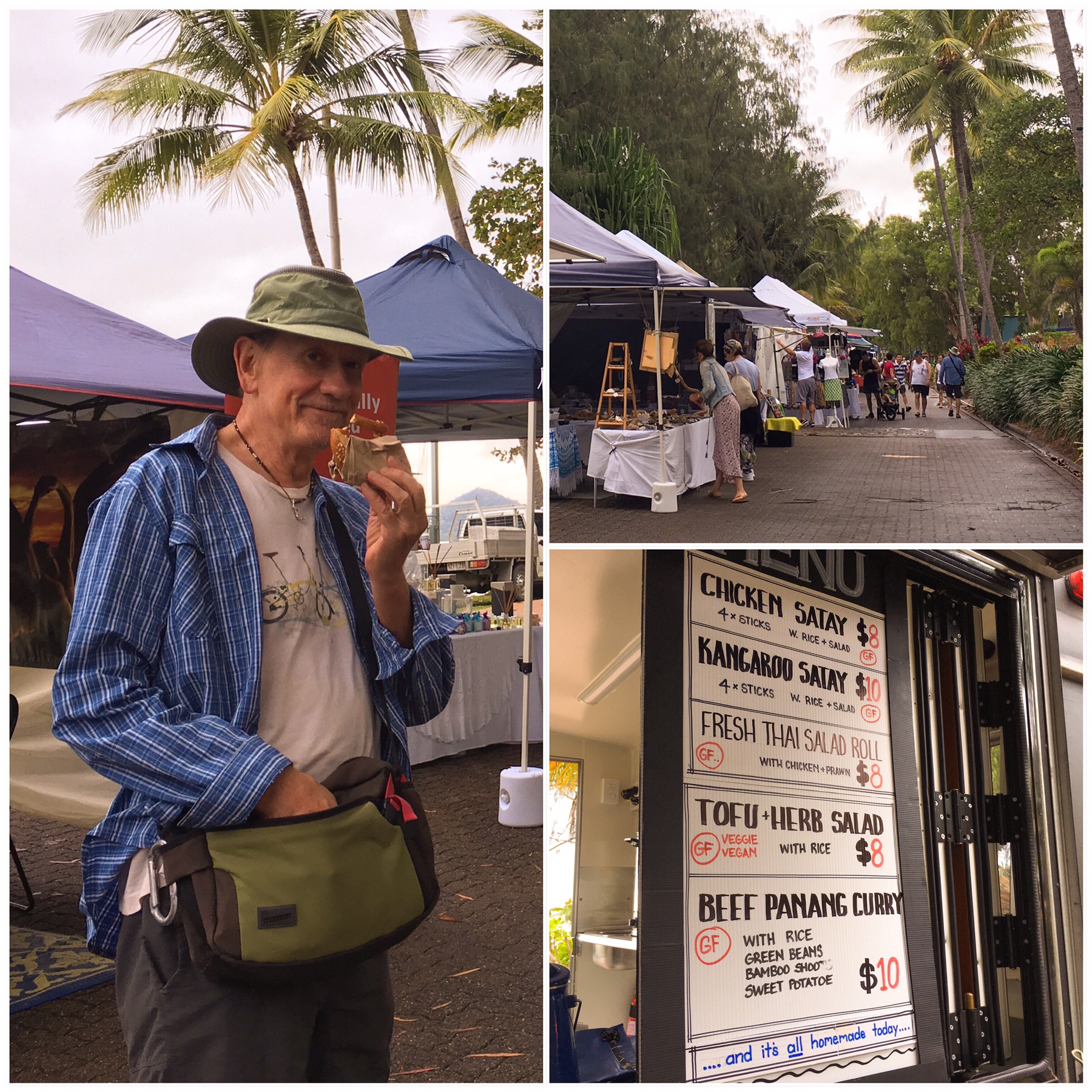 Mrs A managed to score some lovely earrings and a necklace made by three local jewellers, and two dresses beautifully modelled here.
Mrs A managed to score some lovely earrings and a necklace made by three local jewellers, and two dresses beautifully modelled here.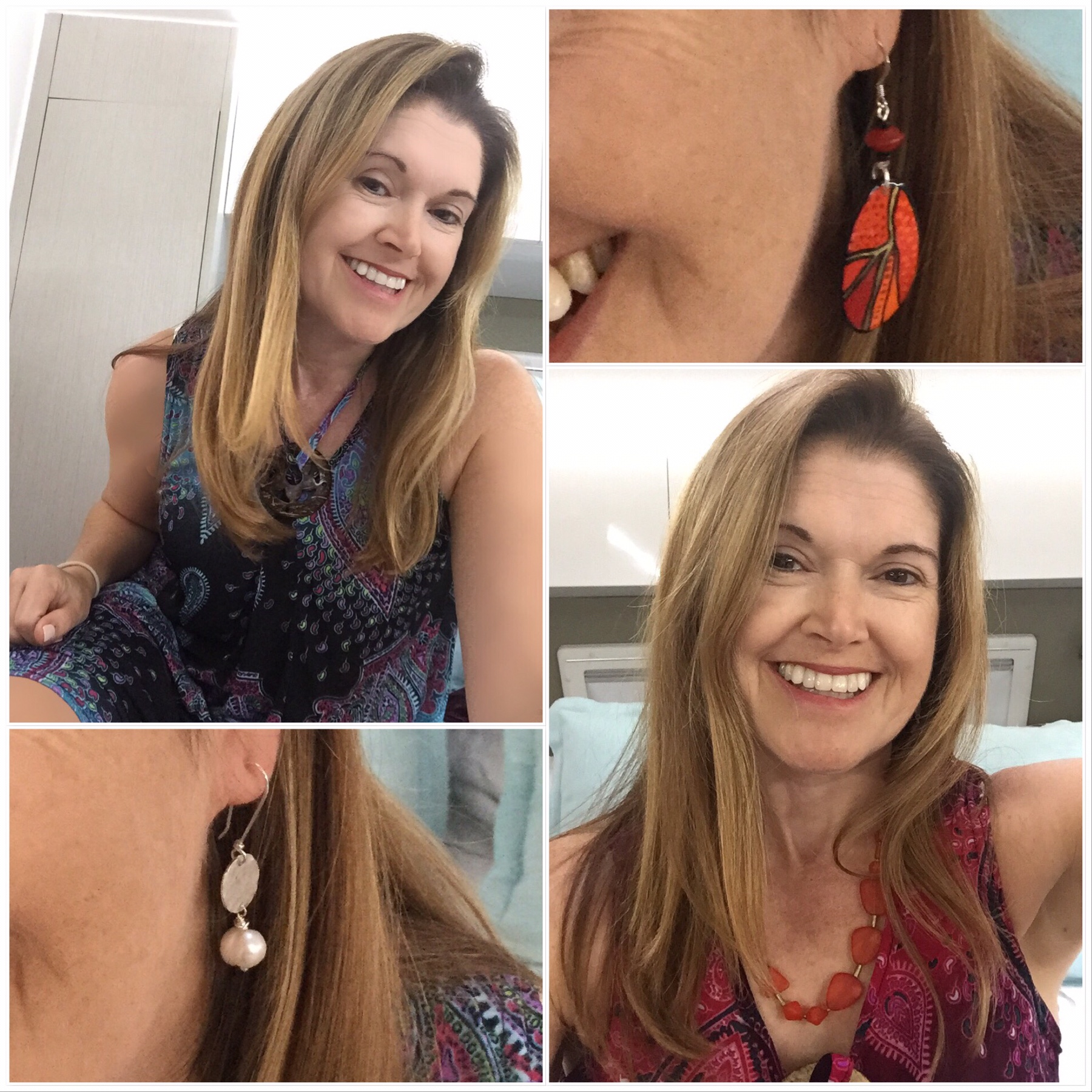 It was with a good degree of excitement that we hitched up and said goodbye to the Coral Sea as the next ocean we are likely to see is the Timor Sea, up in the Gulf.
It was with a good degree of excitement that we hitched up and said goodbye to the Coral Sea as the next ocean we are likely to see is the Timor Sea, up in the Gulf.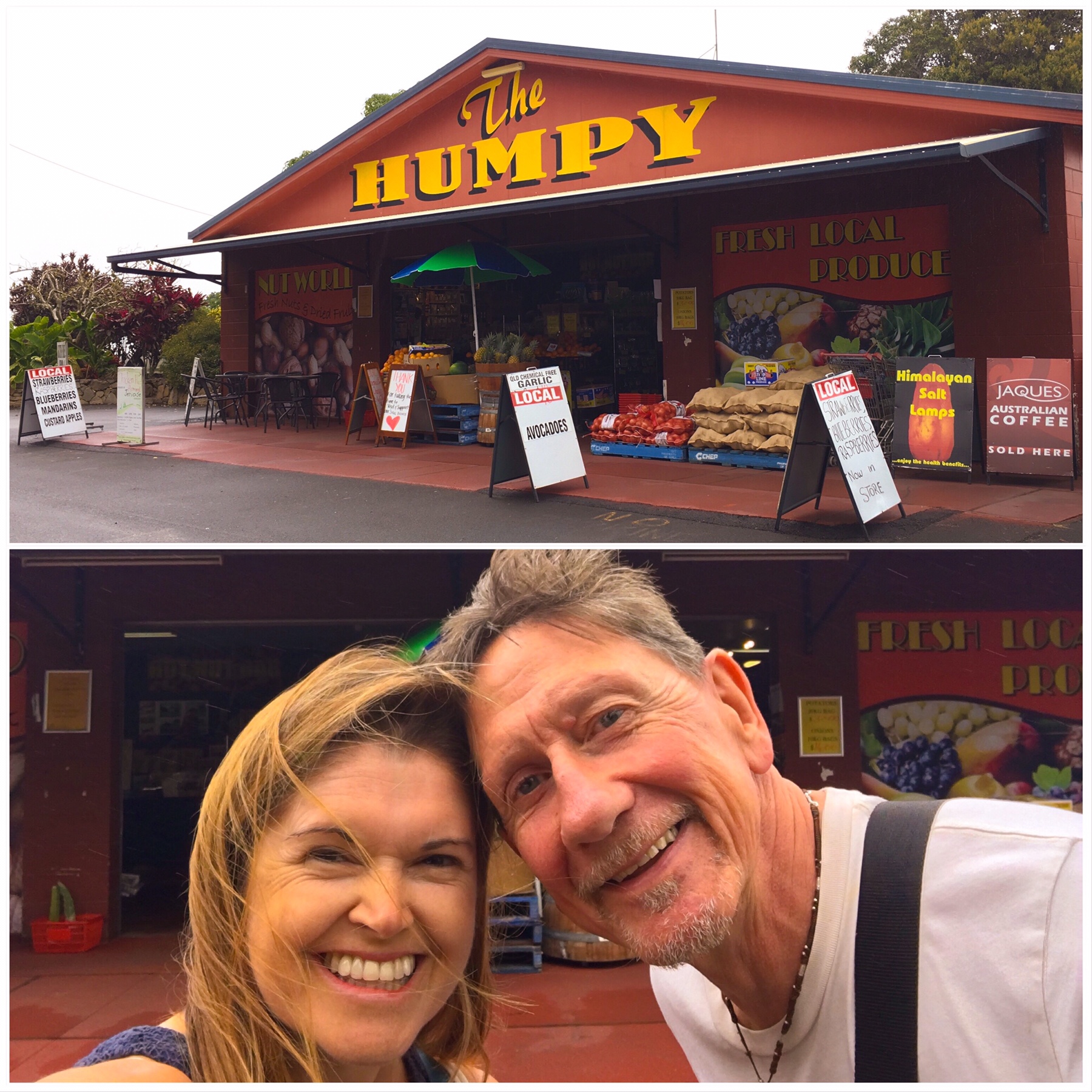 We called back in to our favourite store on the tablelands, the Humpy, for some last minute fruit, vegetables and other local treats, before deciding to press on to a place called Pinnarendi Station. This is another working farm that is making some money from the passing caravans by offering sites with power, water and even meals. Good on them. It’s great to see so many people having a go at something new, seeing an opportunity and investing in some basic facilities for travellers.
We called back in to our favourite store on the tablelands, the Humpy, for some last minute fruit, vegetables and other local treats, before deciding to press on to a place called Pinnarendi Station. This is another working farm that is making some money from the passing caravans by offering sites with power, water and even meals. Good on them. It’s great to see so many people having a go at something new, seeing an opportunity and investing in some basic facilities for travellers.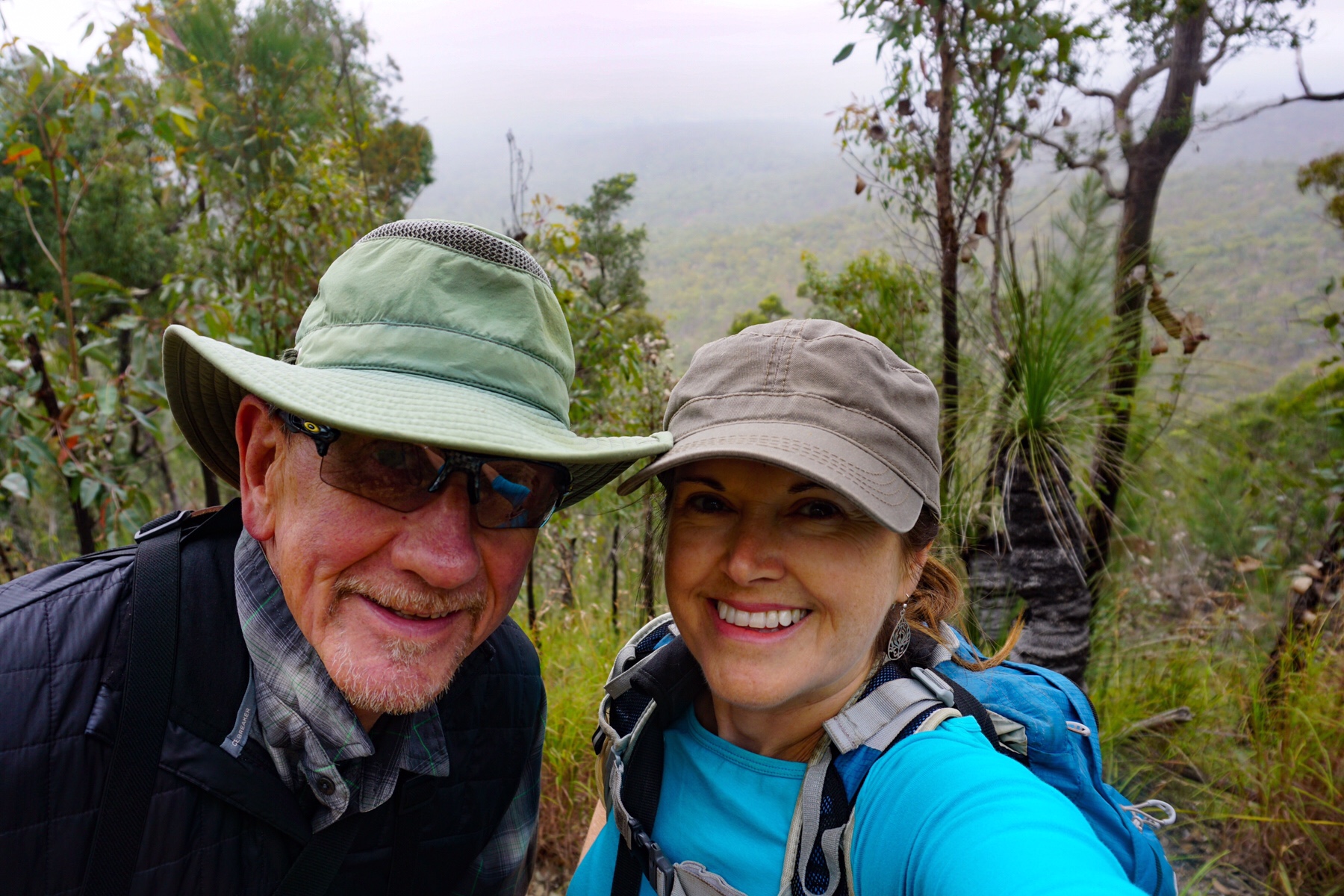 If only the clouds had lifted, which they did when we had finished, it would have been great views across the range.
If only the clouds had lifted, which they did when we had finished, it would have been great views across the range.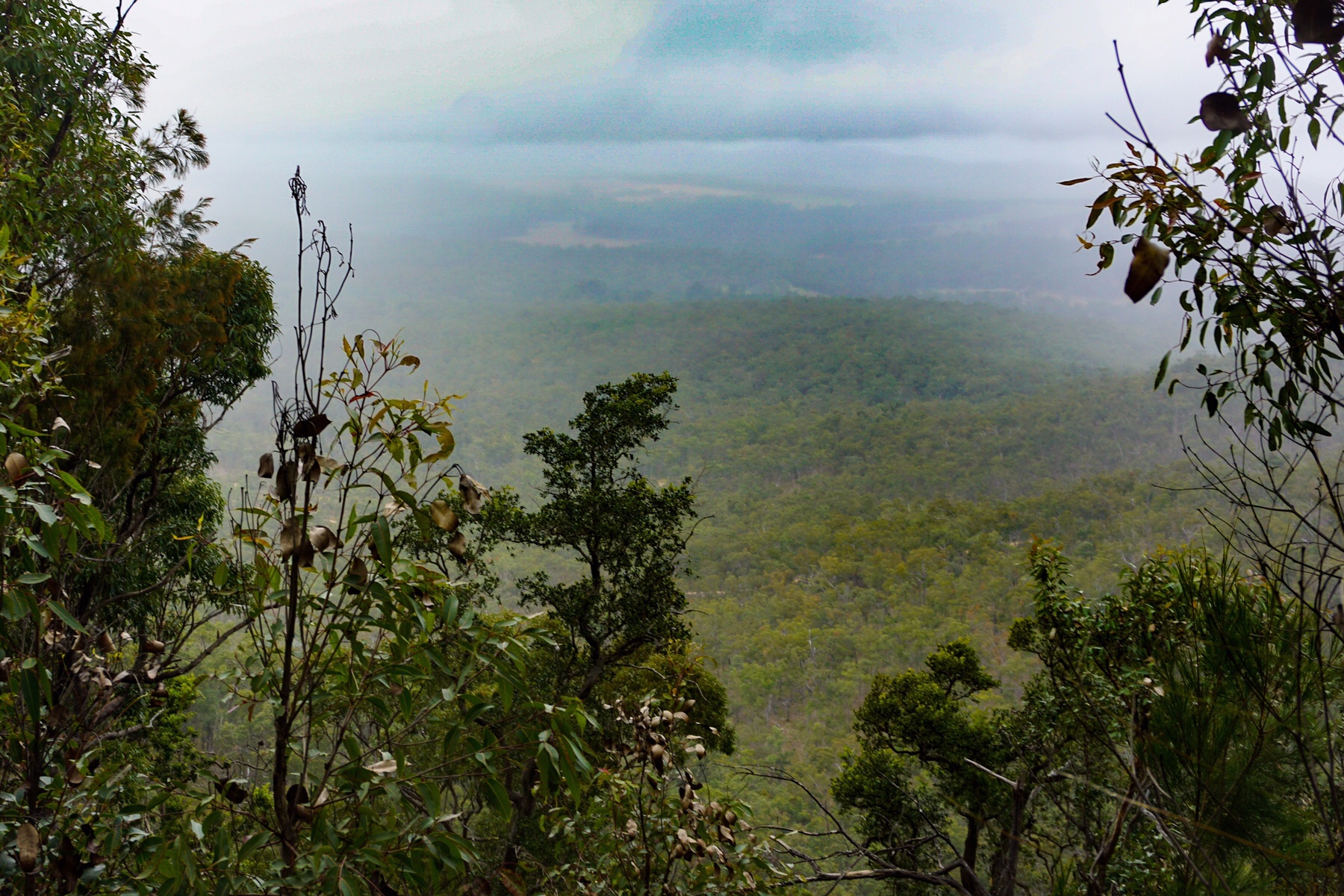
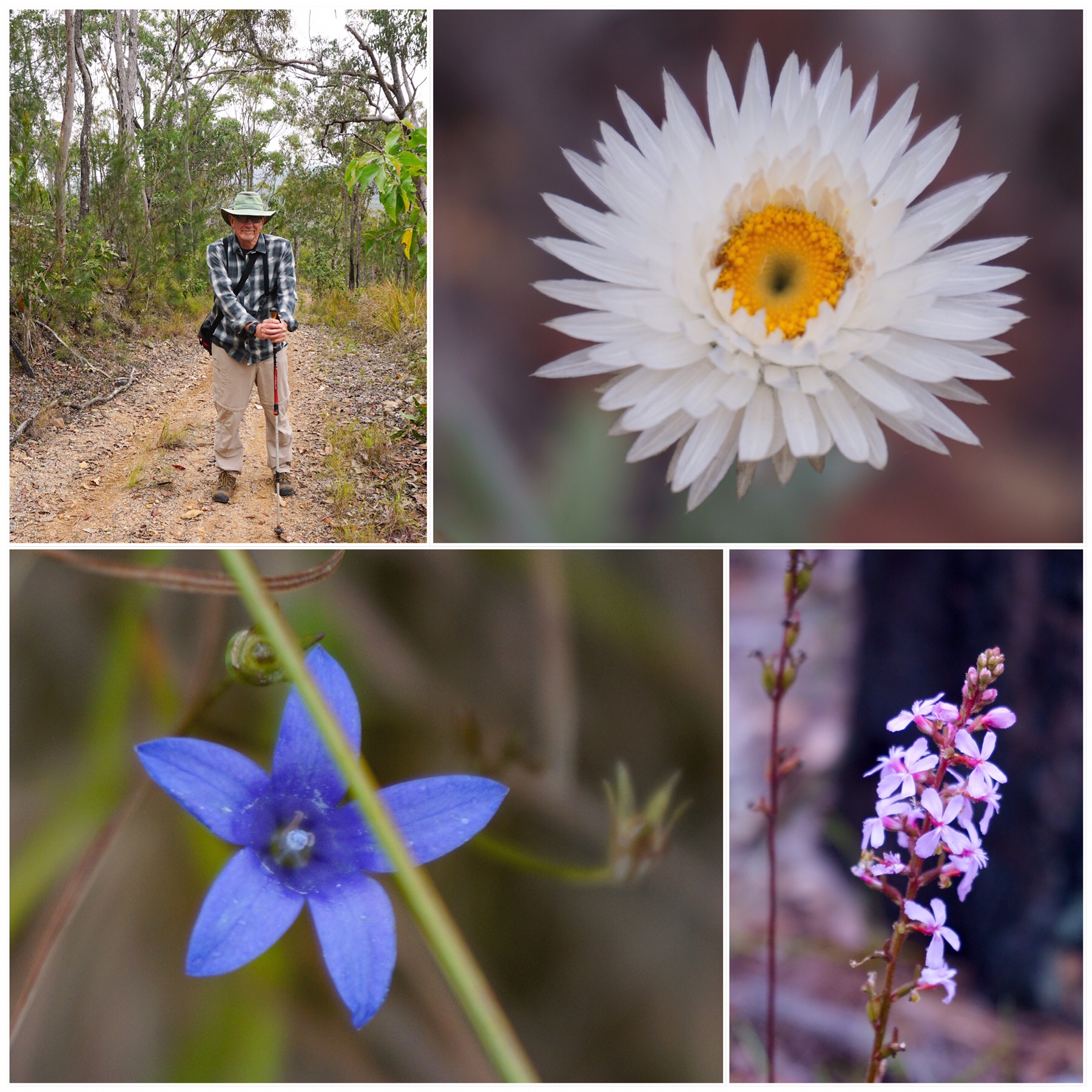
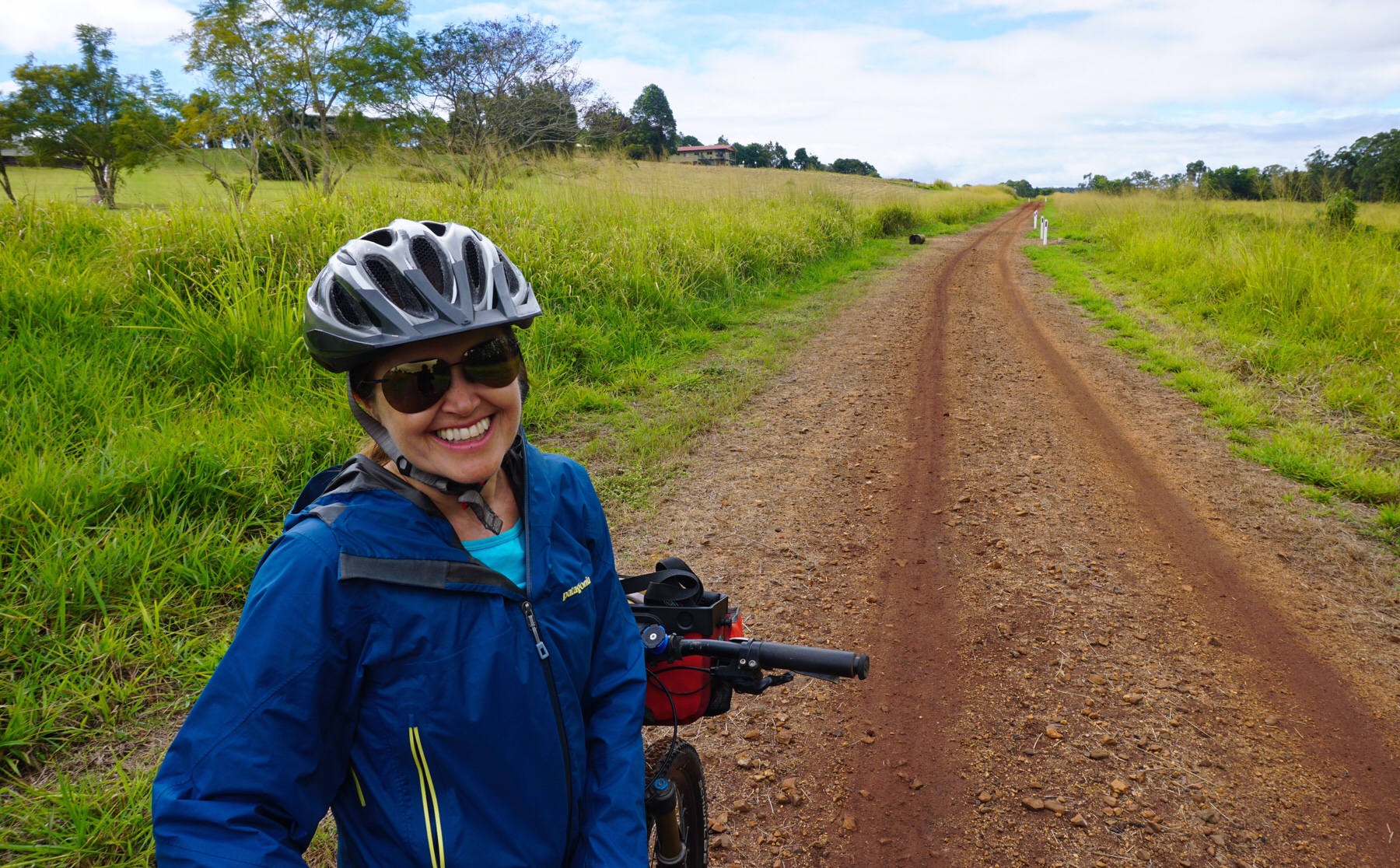 It was actually a great ride initially through a countryside of rolling hills, then we headed round a loop on some tarmac and back to base via a series of local mountain bike trails through the rainforest, ticking off just over 35km.
It was actually a great ride initially through a countryside of rolling hills, then we headed round a loop on some tarmac and back to base via a series of local mountain bike trails through the rainforest, ticking off just over 35km.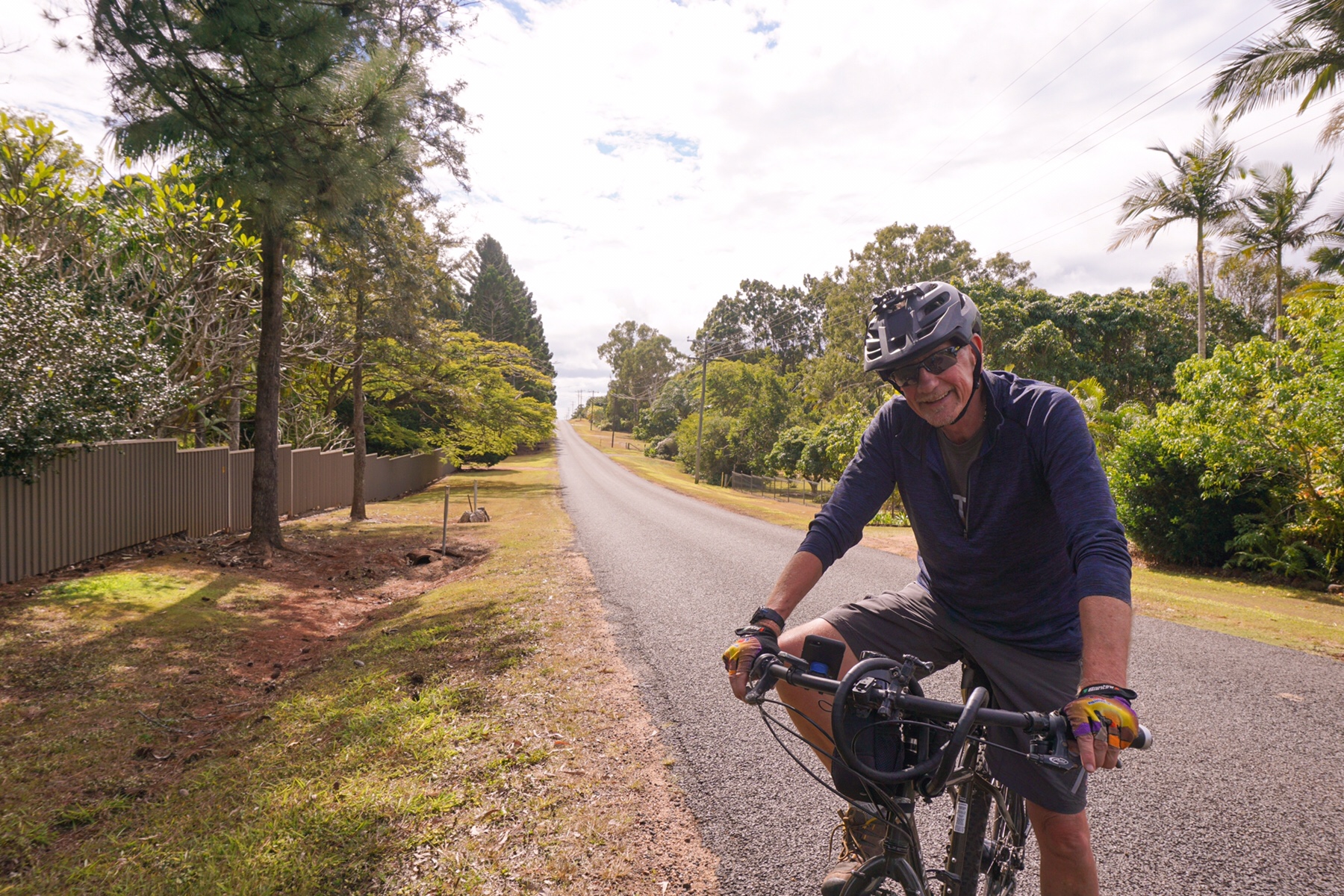
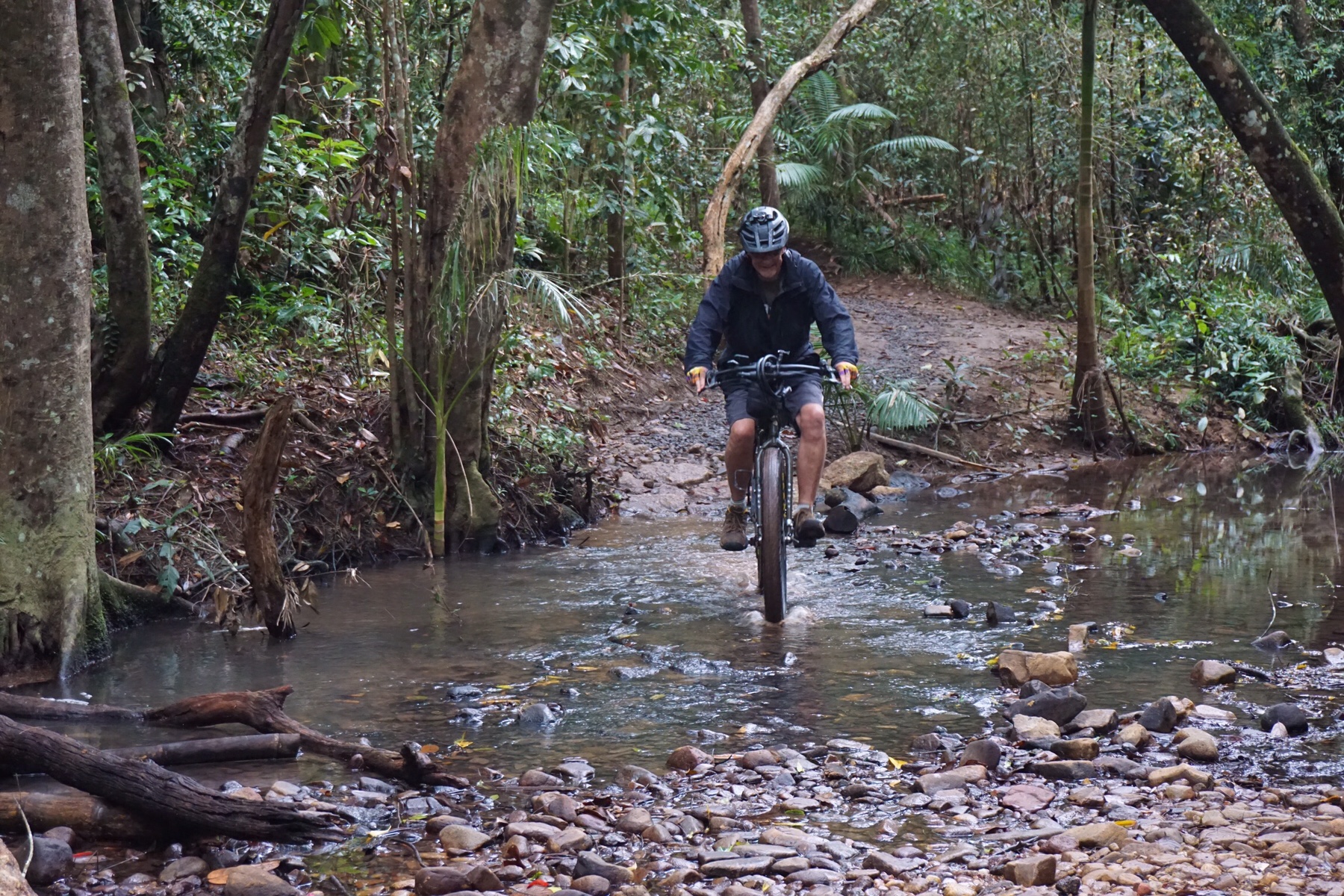 A curry was called for after all that exertion, so our fellow Zoner Ken drove us into Atherton and we we finished our stay here with a great feed. We have really enjoyed the tablelands, apart from the weather, but tomorrow its time to head back down to the coast.
A curry was called for after all that exertion, so our fellow Zoner Ken drove us into Atherton and we we finished our stay here with a great feed. We have really enjoyed the tablelands, apart from the weather, but tomorrow its time to head back down to the coast.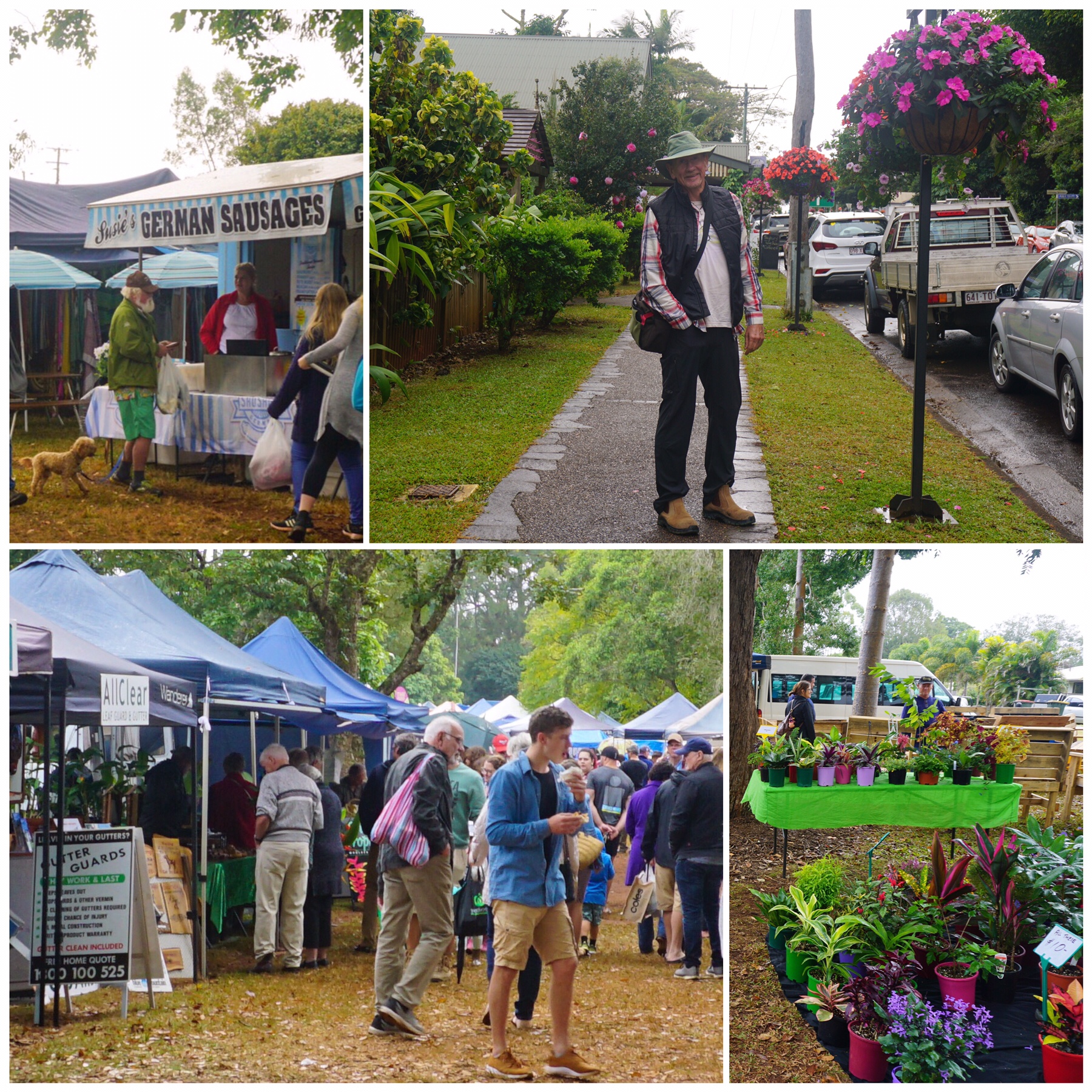 The market was great too. Alongside the stalls of fresh-from-the-farm vegetables and herbs were bakers, jewellers, artists (including musicians, painters, woodworkers, ceramic workers and potters), massage therapists, plants of all varieties, flowers and even fertilised eggs, chicks and chickens for sale. It all felt very authentically country.
The market was great too. Alongside the stalls of fresh-from-the-farm vegetables and herbs were bakers, jewellers, artists (including musicians, painters, woodworkers, ceramic workers and potters), massage therapists, plants of all varieties, flowers and even fertilised eggs, chicks and chickens for sale. It all felt very authentically country.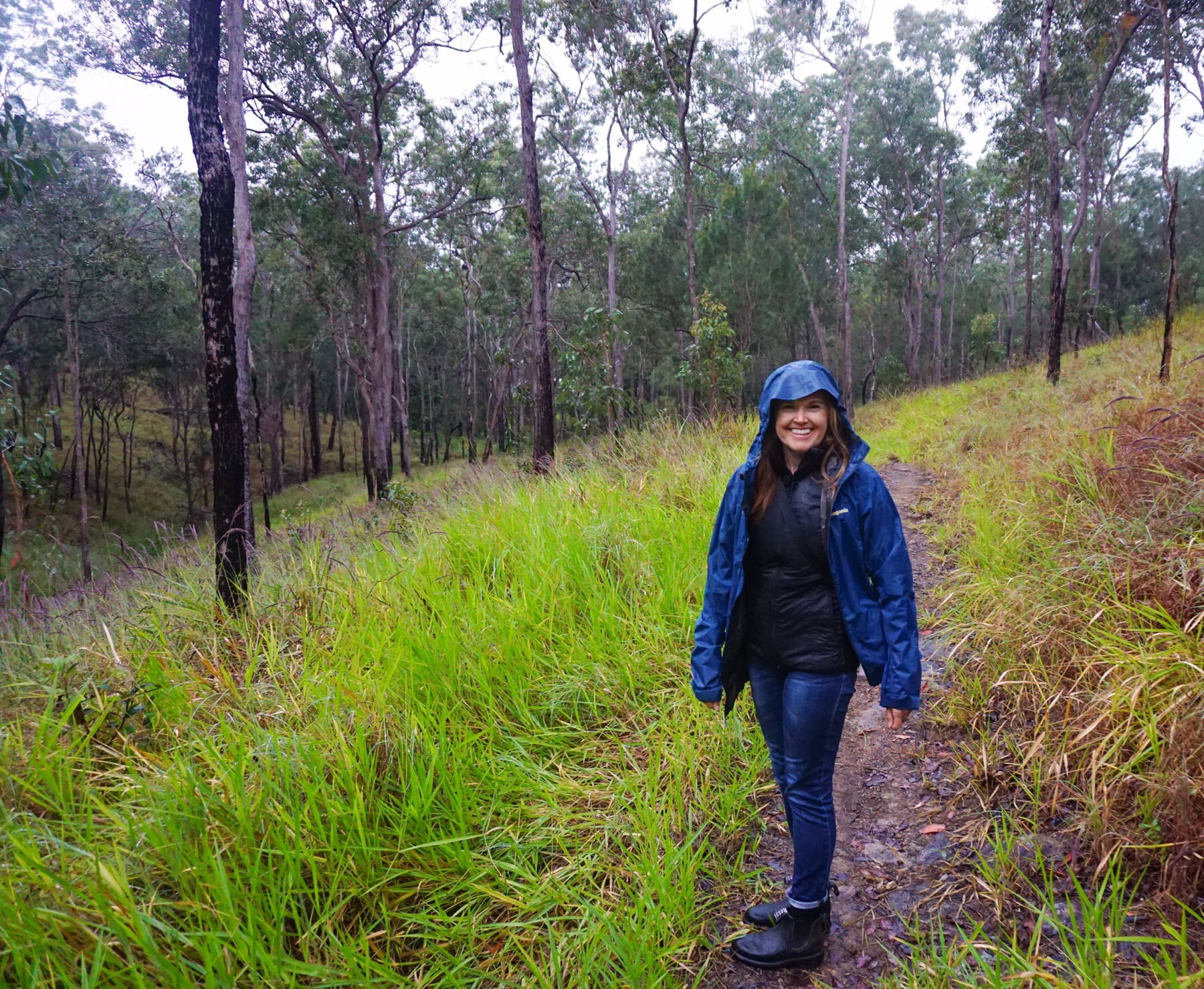
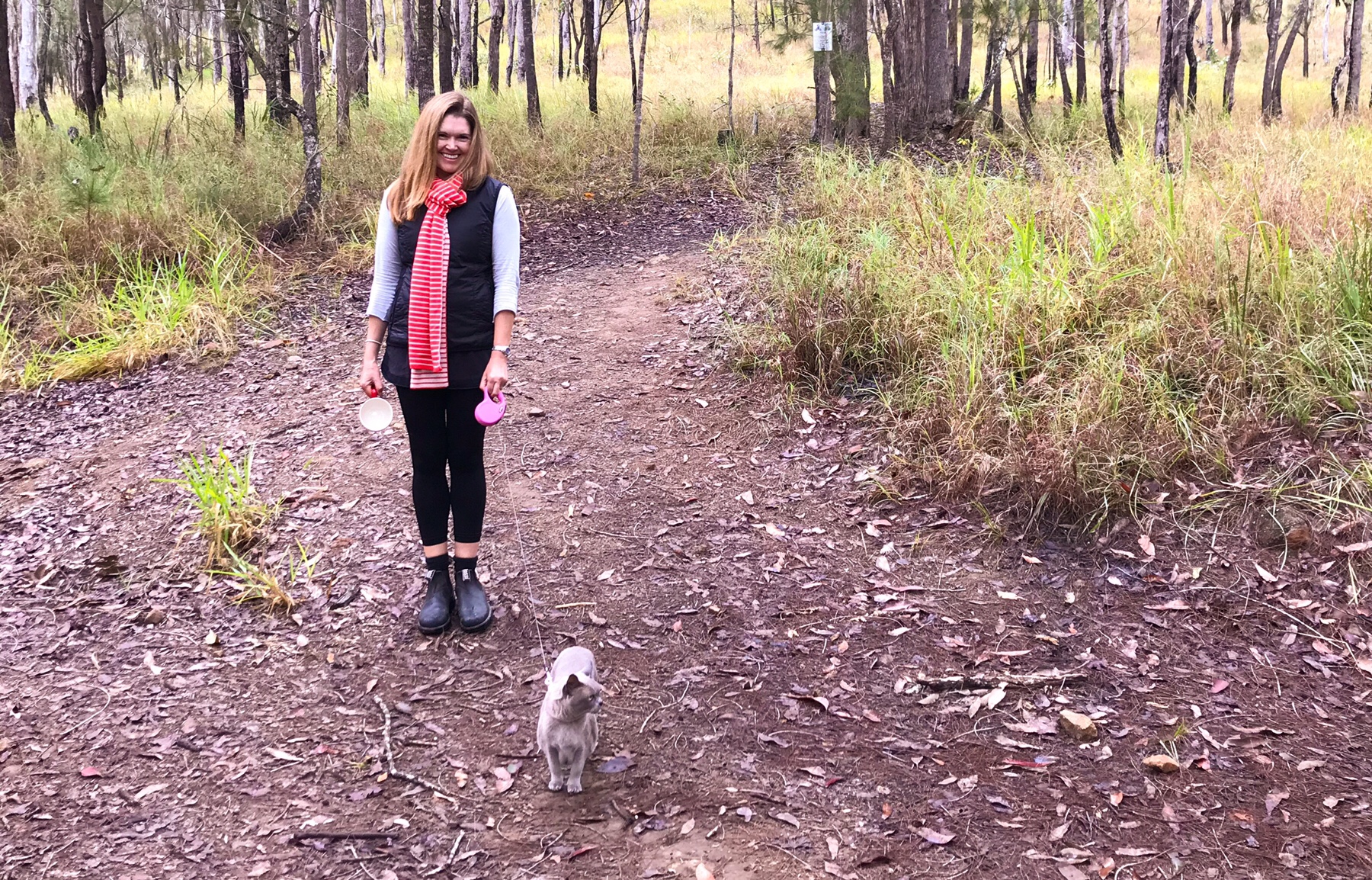 Again, we didn’t get too far before Tassie decided it was time to return to the Zone. She always amazes me with her courage – as a 14 year old predominantly indoor/garden cat, she had not really travelled much before last September, but now she’s been right across Australia. She always knows where the safe Zone is, and keeps her wits about her, even when being dive bombed by birds…they don’t seem to understand she’s a lover not a catcher!
Again, we didn’t get too far before Tassie decided it was time to return to the Zone. She always amazes me with her courage – as a 14 year old predominantly indoor/garden cat, she had not really travelled much before last September, but now she’s been right across Australia. She always knows where the safe Zone is, and keeps her wits about her, even when being dive bombed by birds…they don’t seem to understand she’s a lover not a catcher!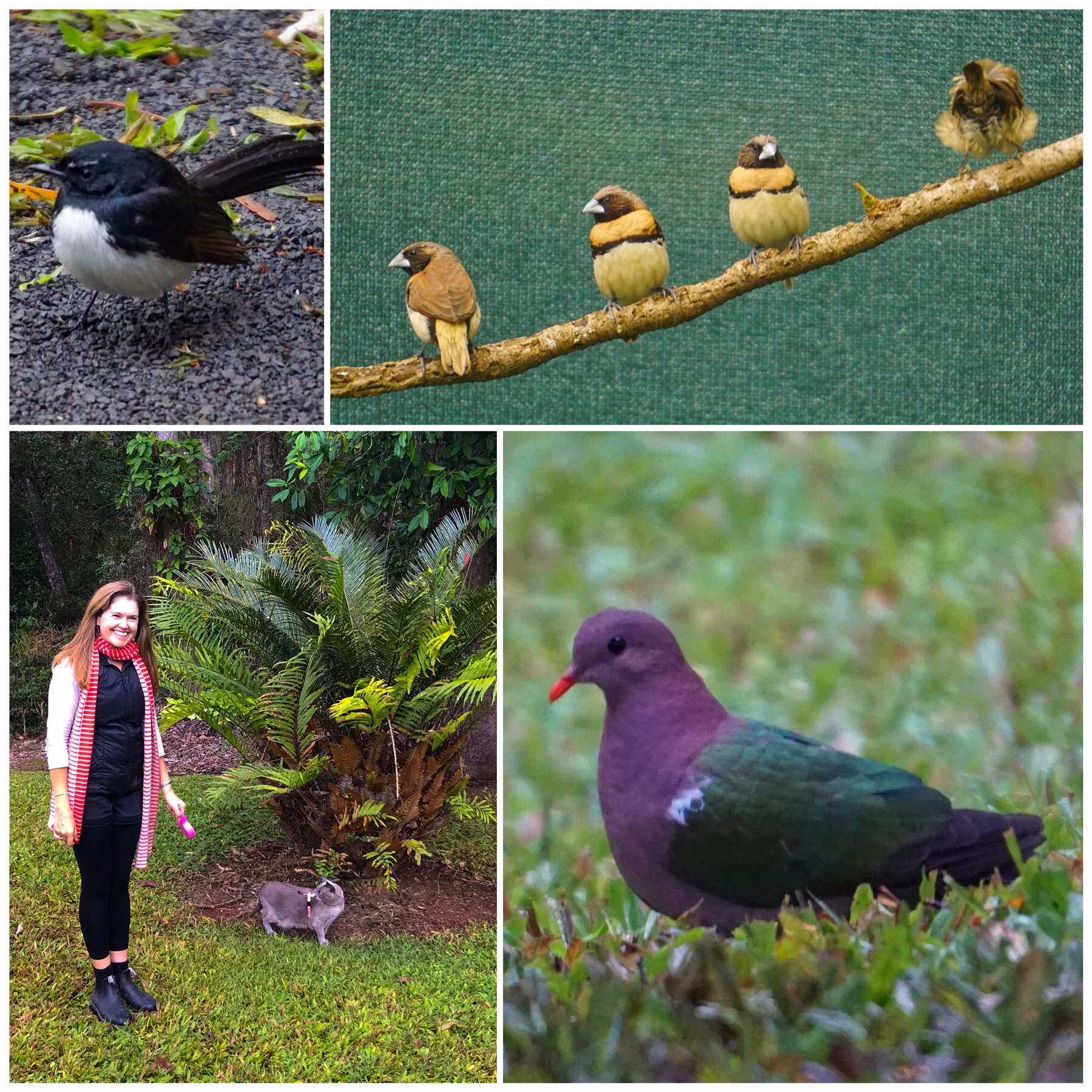 There are plenty of birds here. We have spotted pale yellow robins, firetails, finches galore, and lovely purple and green fruit doves feeding on the mandarins on and below the tree beside where we are camped. The little black and white Willy Wagtail is the feisty one, always flying at Tassie and frightening her back indoors. I guess he’s met some hungrier cats in his lifetime.
There are plenty of birds here. We have spotted pale yellow robins, firetails, finches galore, and lovely purple and green fruit doves feeding on the mandarins on and below the tree beside where we are camped. The little black and white Willy Wagtail is the feisty one, always flying at Tassie and frightening her back indoors. I guess he’s met some hungrier cats in his lifetime.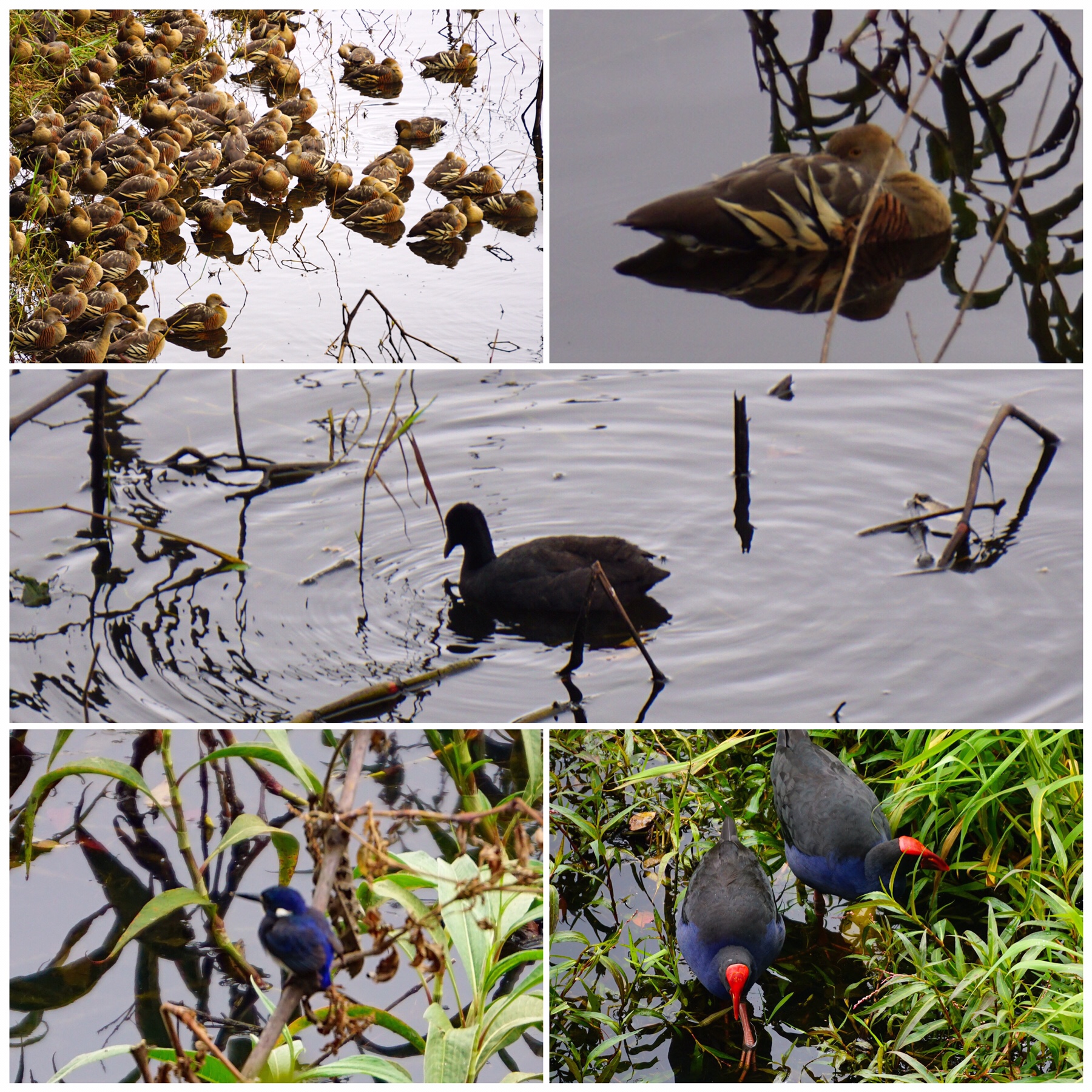 Soon the cheese was calling, and off we went to the farm where Mr A tried some cheese and purchased a delicious (according to him) blue.
Soon the cheese was calling, and off we went to the farm where Mr A tried some cheese and purchased a delicious (according to him) blue.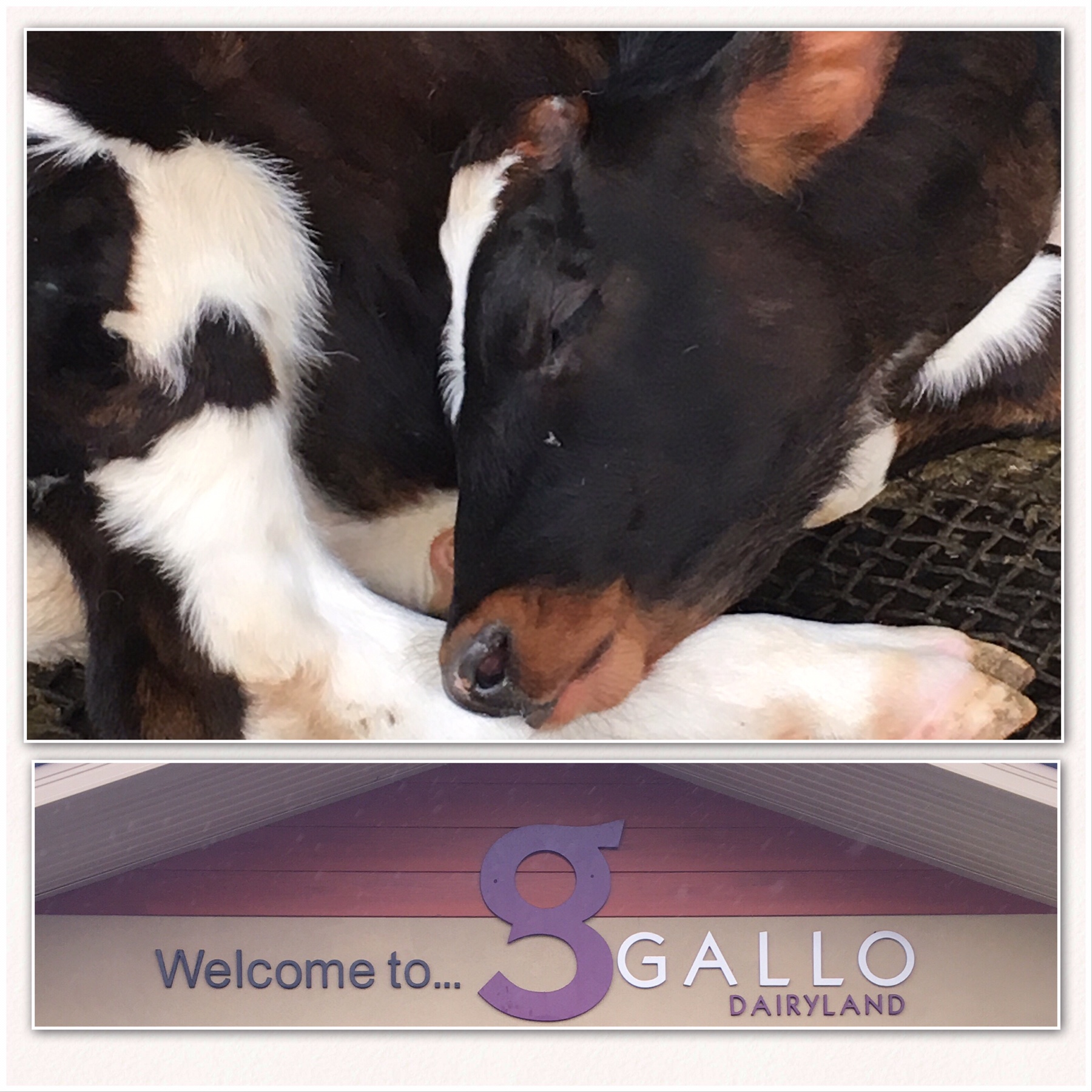 From here we drove a short way to another little national park – home to the Curtain Fig. This tree is a survivor in a small patch of remaining rainforest which was saved from the saw in the 1800s by the rocky surface, not ideal for grazing.
From here we drove a short way to another little national park – home to the Curtain Fig. This tree is a survivor in a small patch of remaining rainforest which was saved from the saw in the 1800s by the rocky surface, not ideal for grazing. 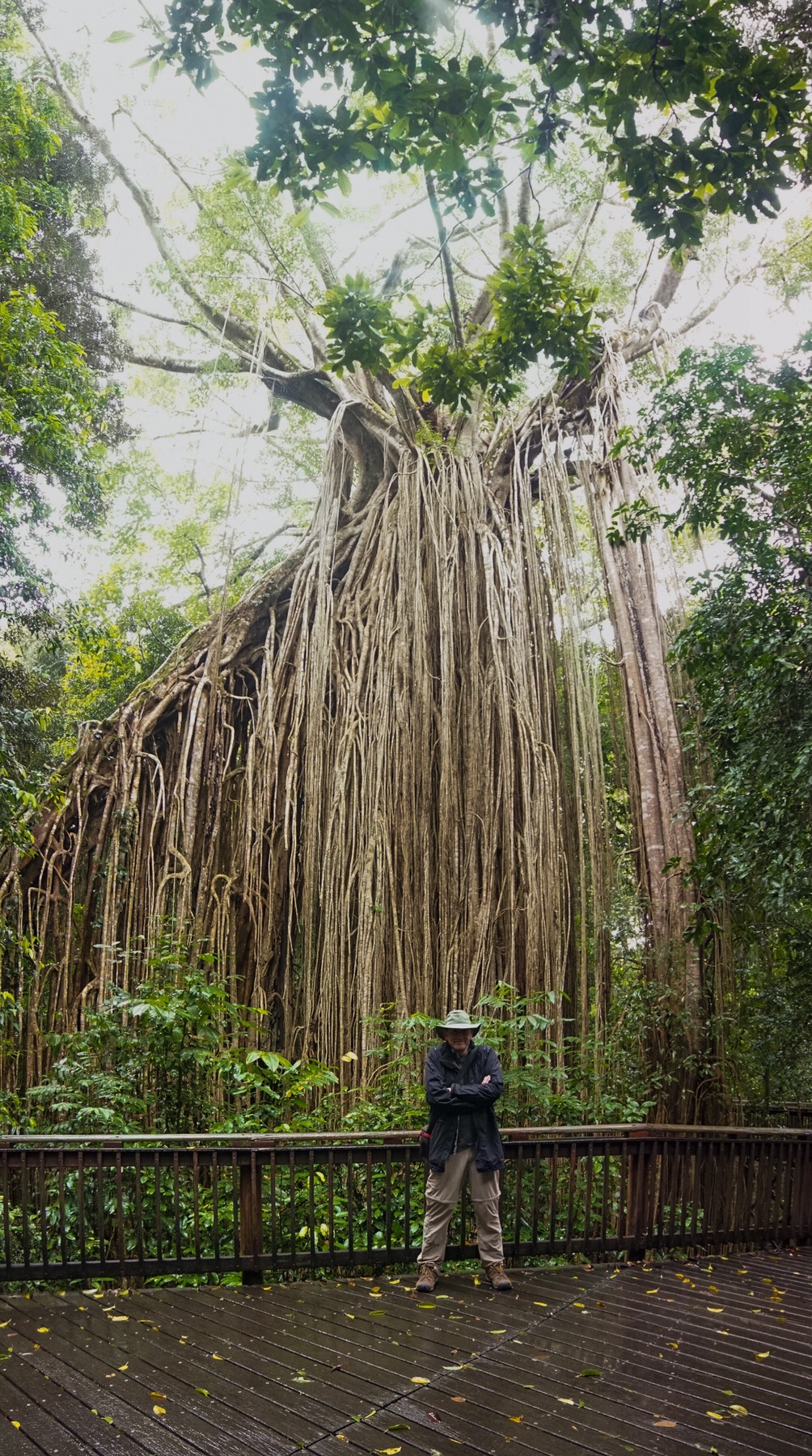 It is protected by a raised boardwalk, and pretty magnificent.
It is protected by a raised boardwalk, and pretty magnificent.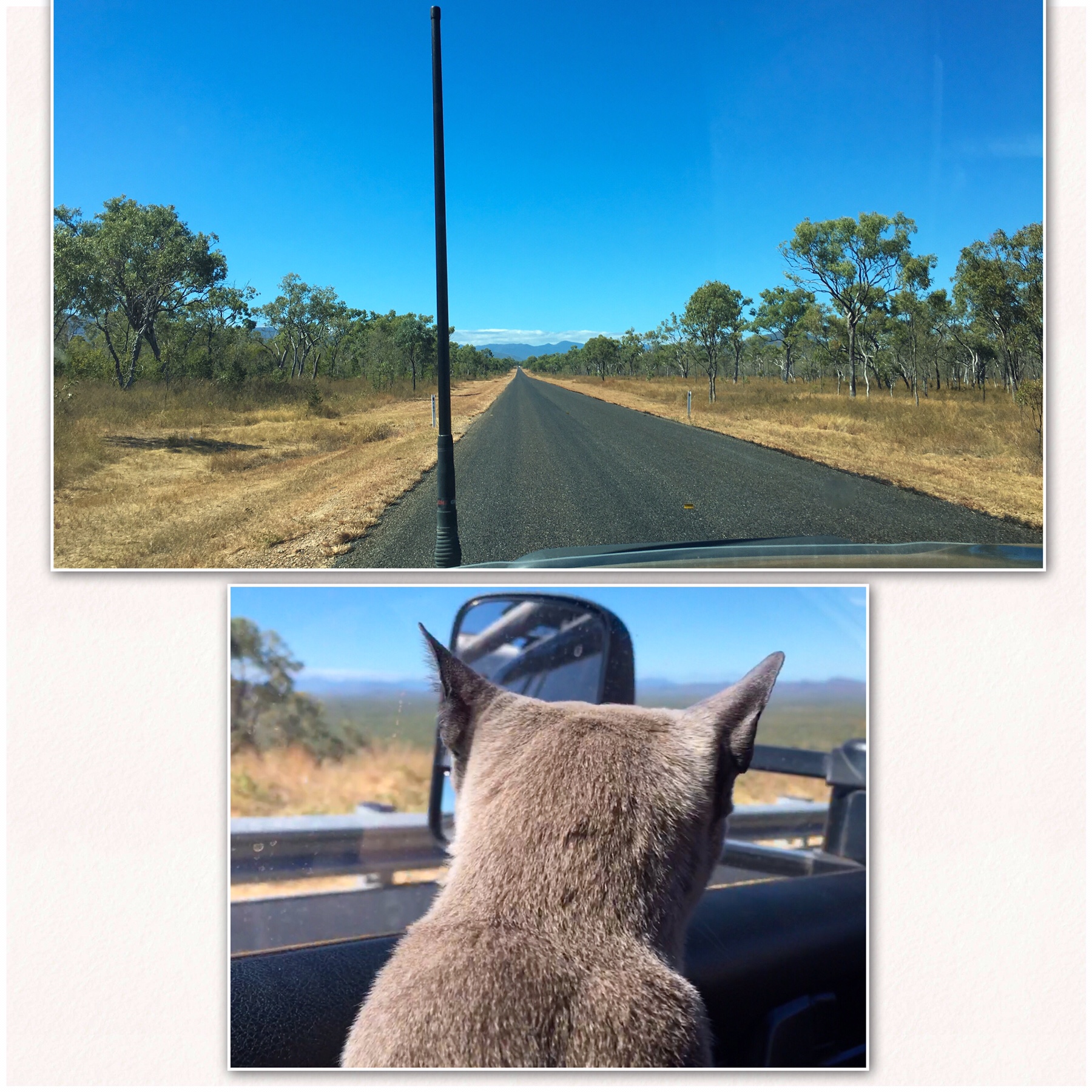 Mareeba didn’t tempt us in to town, and it had a very uninspiring campsite as well, so after the using the time to clean sheets, clothes, truck and Zone we decided to head off to Atherton, the main town up here on the tablelands.
Mareeba didn’t tempt us in to town, and it had a very uninspiring campsite as well, so after the using the time to clean sheets, clothes, truck and Zone we decided to head off to Atherton, the main town up here on the tablelands.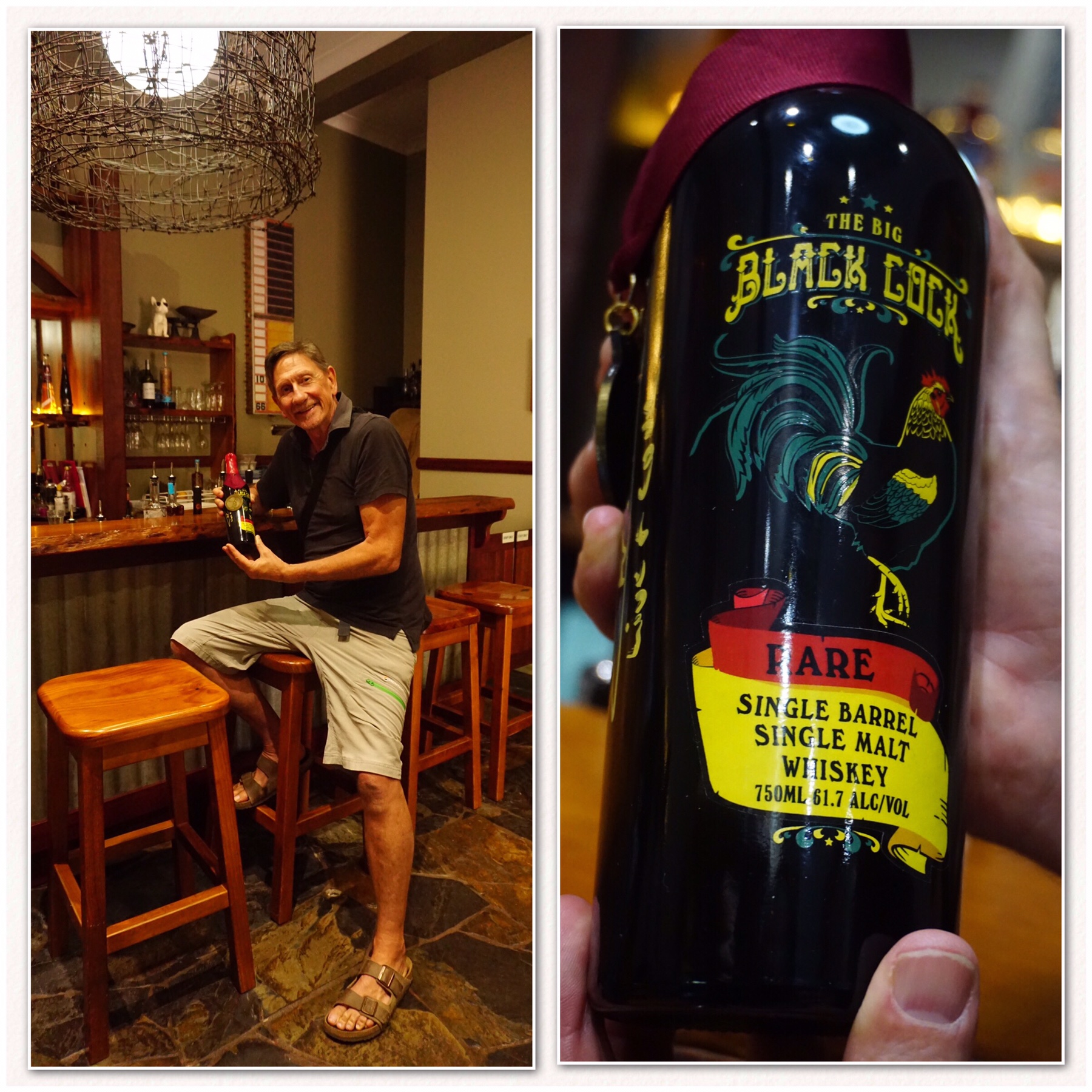 Moving on, we called in at our first fruit and veggie shop on the tablelands. If you’re not au fait with the area then you should know it is famous for its basalt soils and temperate climate that encourages an incredible range of produce. Almost everything seems to grow up here!
Moving on, we called in at our first fruit and veggie shop on the tablelands. If you’re not au fait with the area then you should know it is famous for its basalt soils and temperate climate that encourages an incredible range of produce. Almost everything seems to grow up here!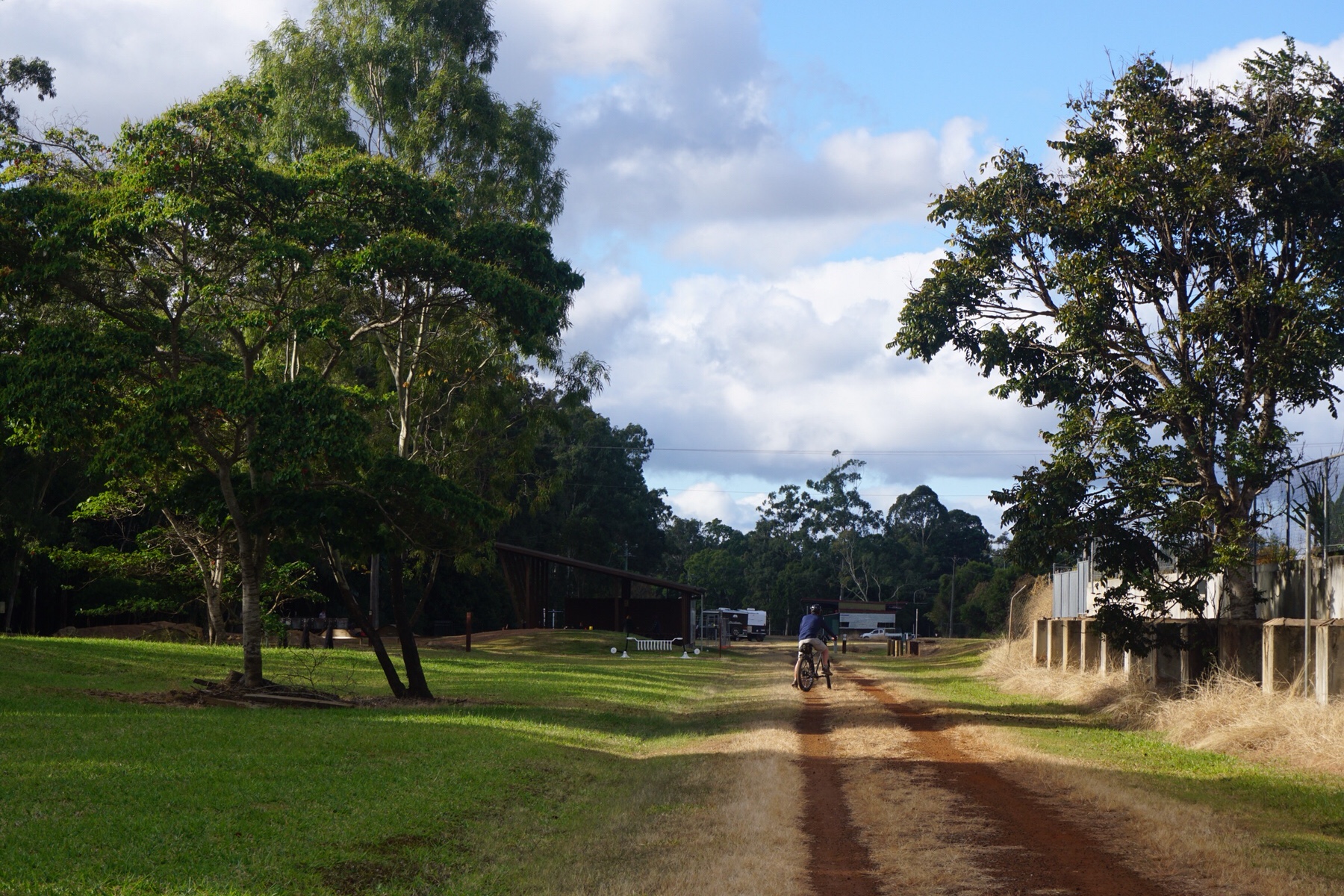 ….And then…we spot another Zone parked by us. So we all introduce ourselves and it turns out the Zoner (Ken, owner of #101) was someone I had already previously messaged to meet up in Cairns, as I had seen he had just picked up his van.
….And then…we spot another Zone parked by us. So we all introduce ourselves and it turns out the Zoner (Ken, owner of #101) was someone I had already previously messaged to meet up in Cairns, as I had seen he had just picked up his van.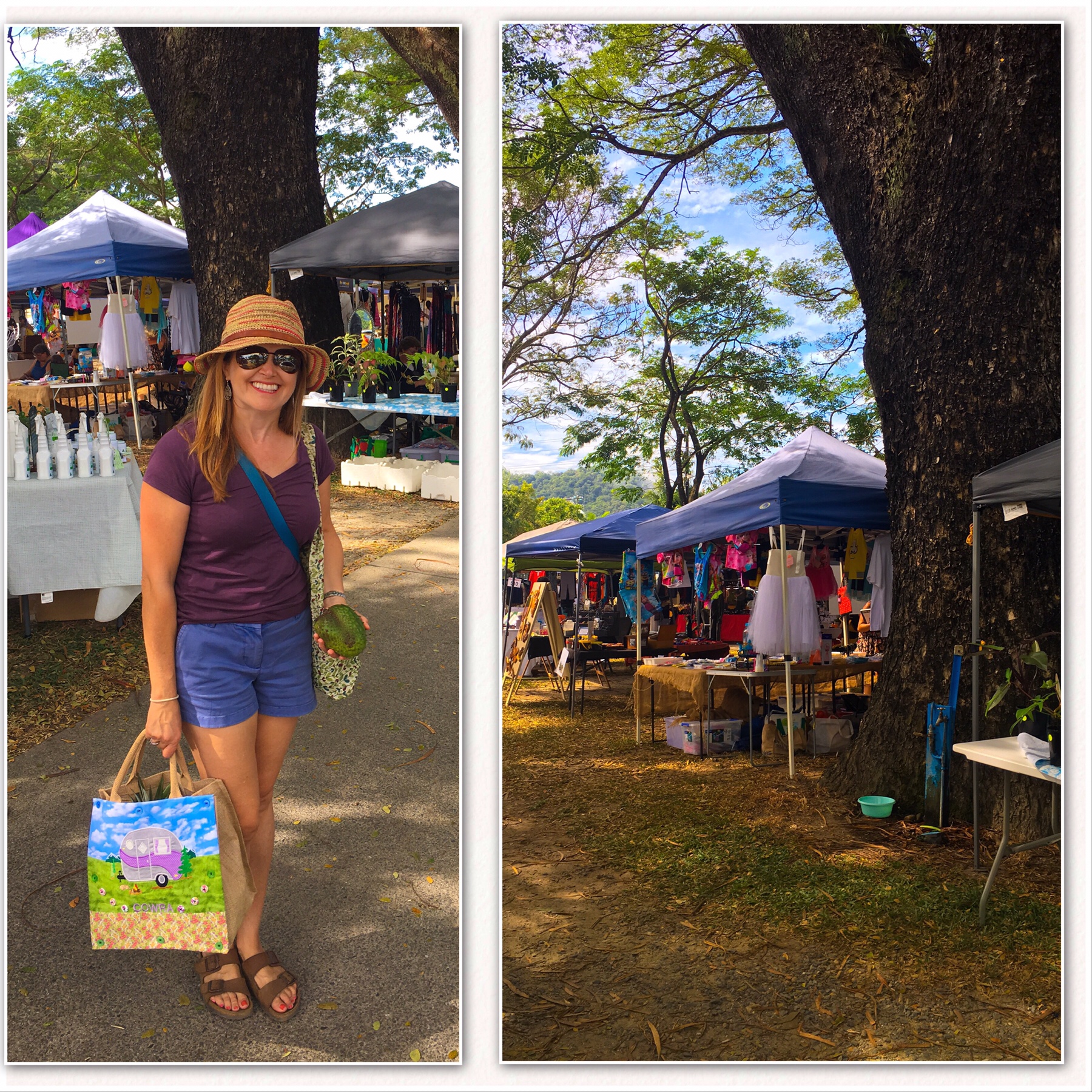 We finished up with a whole range of other fresh locally grown fruit and veg, so with our fridge crammed to capacity, we then turned off the coast road we had followed for so long and headed inland, up onto the north end of the Atherton Tablelands. We watched the scenery change dramatically as we climbed up the range, the Cruiser doing its usual impeccable job of dragging the 3 tons of loaded up Zone up the steep climb. Our destination was a place called Bustard Downs, a working cattle farm with some camp spots we would stay the night on. As we drove down onto the property we were immediately struck by the amount of birds around.
We finished up with a whole range of other fresh locally grown fruit and veg, so with our fridge crammed to capacity, we then turned off the coast road we had followed for so long and headed inland, up onto the north end of the Atherton Tablelands. We watched the scenery change dramatically as we climbed up the range, the Cruiser doing its usual impeccable job of dragging the 3 tons of loaded up Zone up the steep climb. Our destination was a place called Bustard Downs, a working cattle farm with some camp spots we would stay the night on. As we drove down onto the property we were immediately struck by the amount of birds around.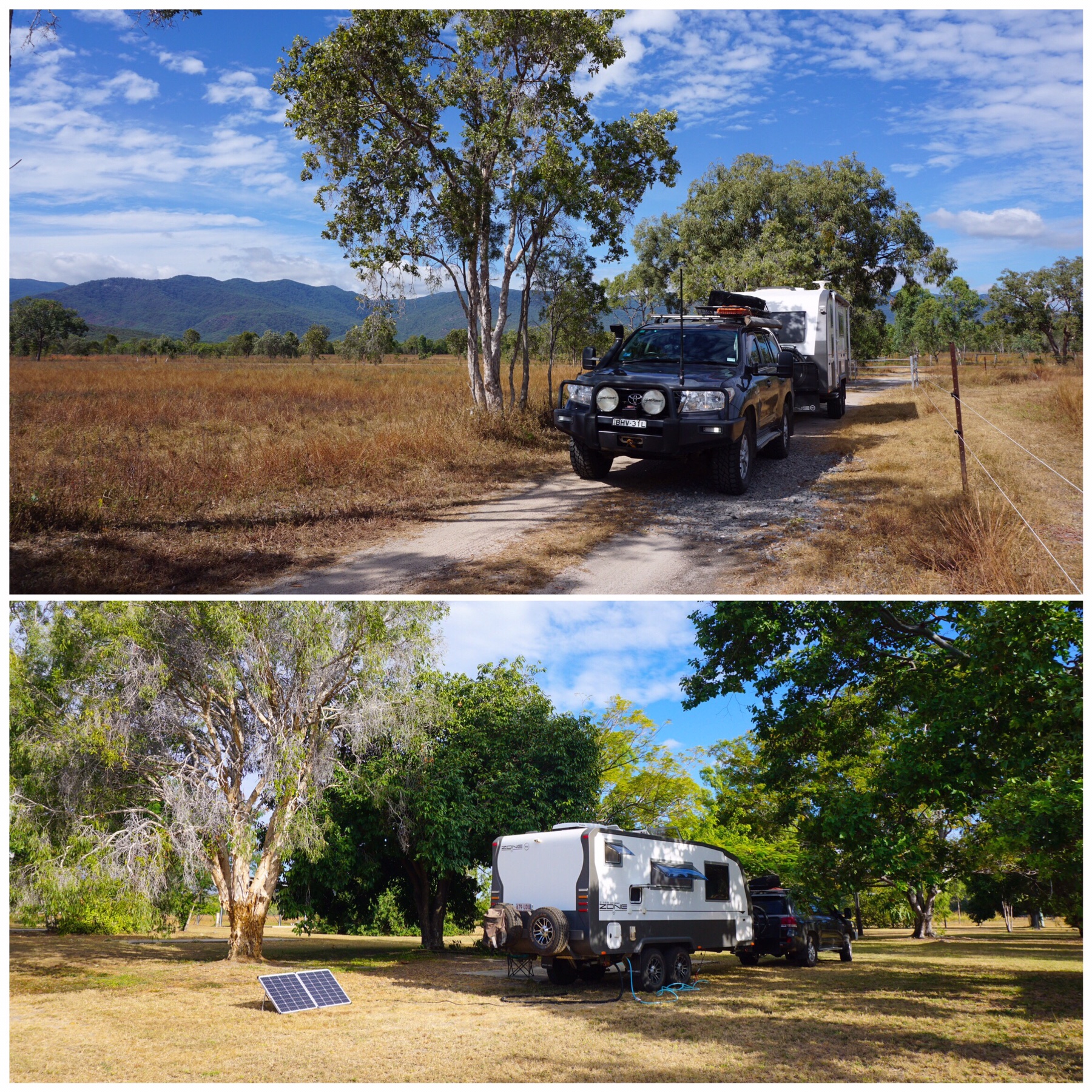 When we met the owner she said around 150 different types have been logged by local birders, so we set off to explore.
When we met the owner she said around 150 different types have been logged by local birders, so we set off to explore. 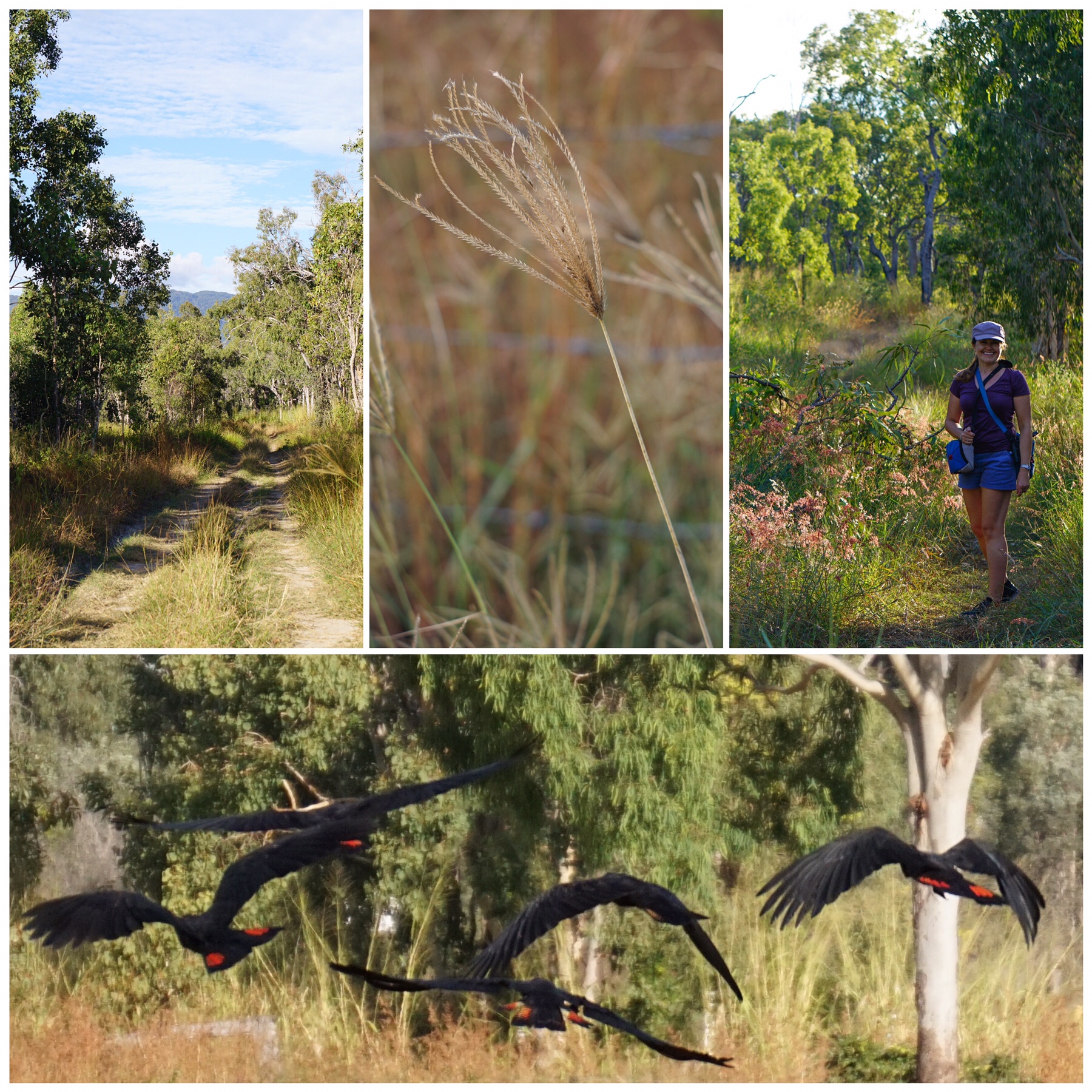
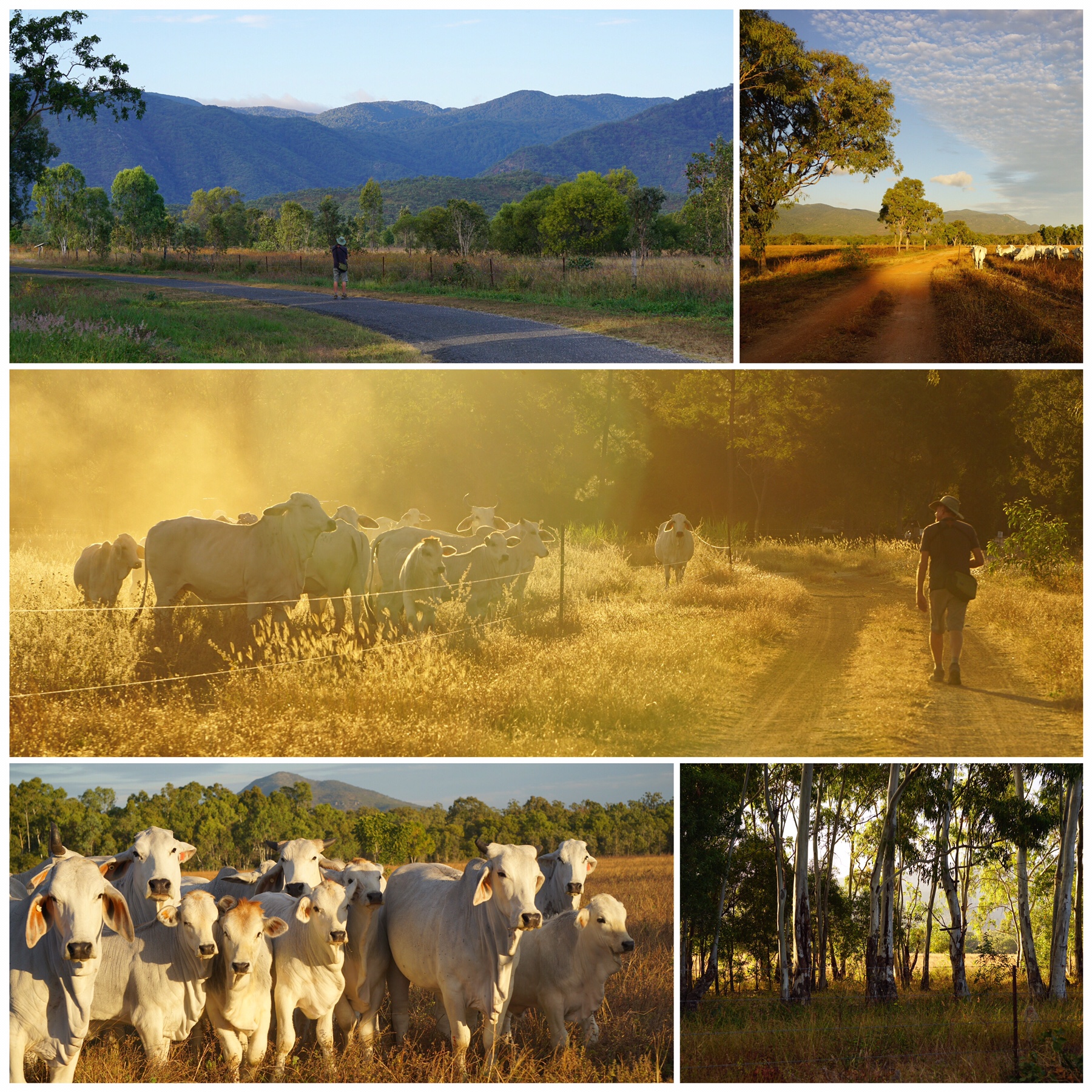 Even the cattle were beautiful!
Even the cattle were beautiful!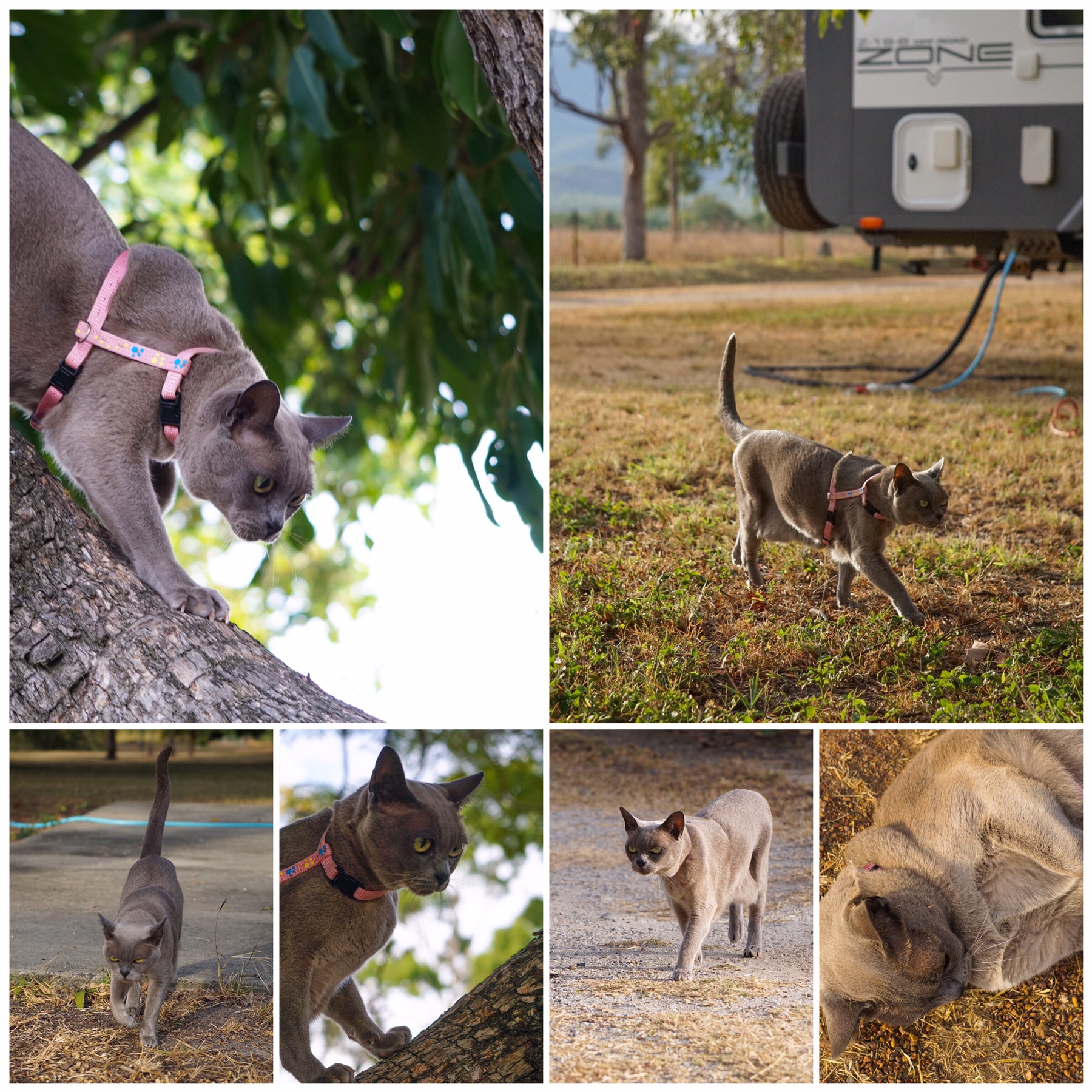 Only one other caravan was there on the whole of the property, well until 6.30 pm when it was pitch black, and we are in full dinner prep mode for a nasi goreng feast, with me wearing a clear plastic glove on one hand as I was cutting up the turmeric (it stains your skin yellow)..and there was knock on the door. I opened to find a lady at the door, another van had pulled up right next to us. They had been delayed on the road after hitting a kangaroo and she was asking me where the camp office was.
Only one other caravan was there on the whole of the property, well until 6.30 pm when it was pitch black, and we are in full dinner prep mode for a nasi goreng feast, with me wearing a clear plastic glove on one hand as I was cutting up the turmeric (it stains your skin yellow)..and there was knock on the door. I opened to find a lady at the door, another van had pulled up right next to us. They had been delayed on the road after hitting a kangaroo and she was asking me where the camp office was.